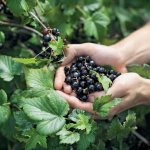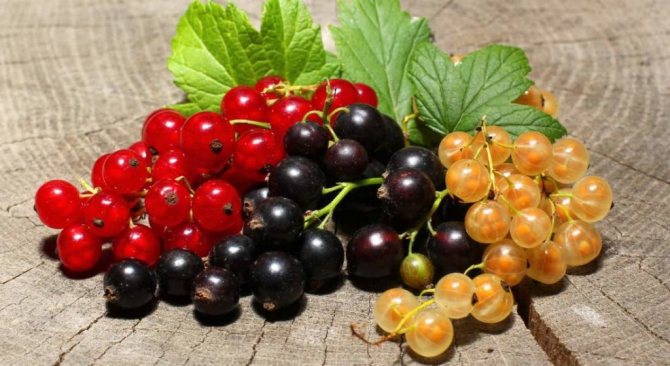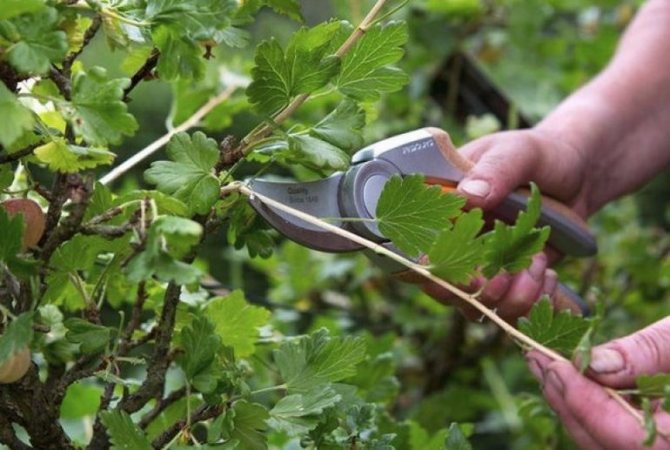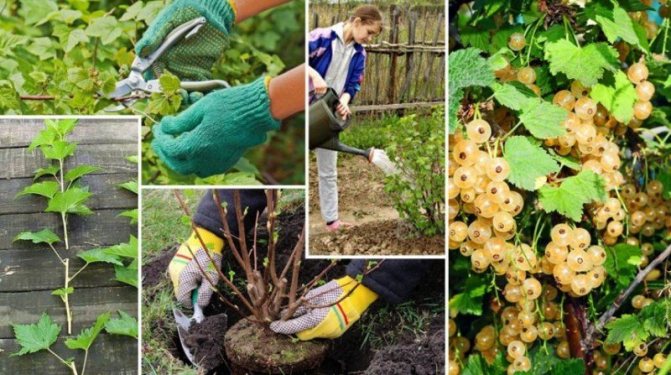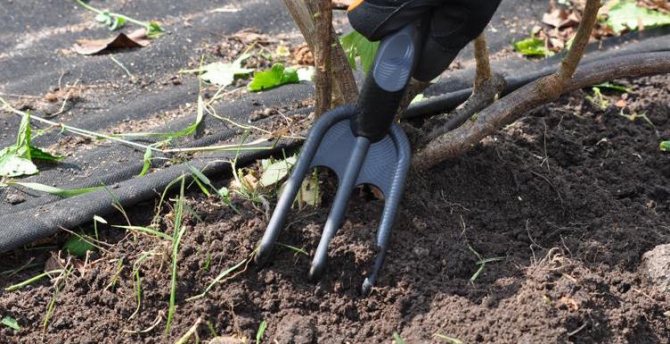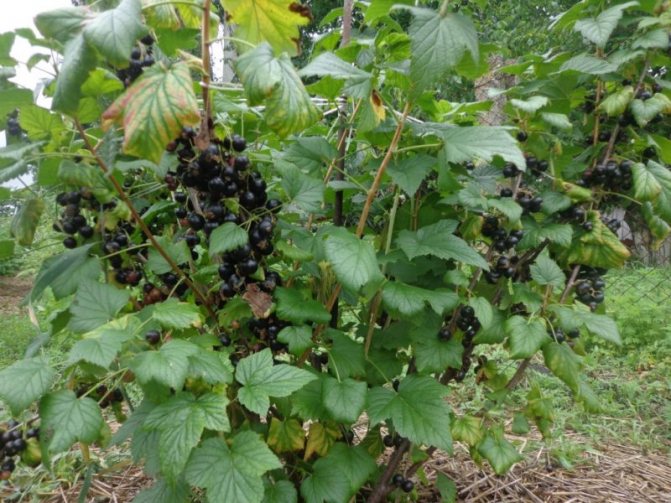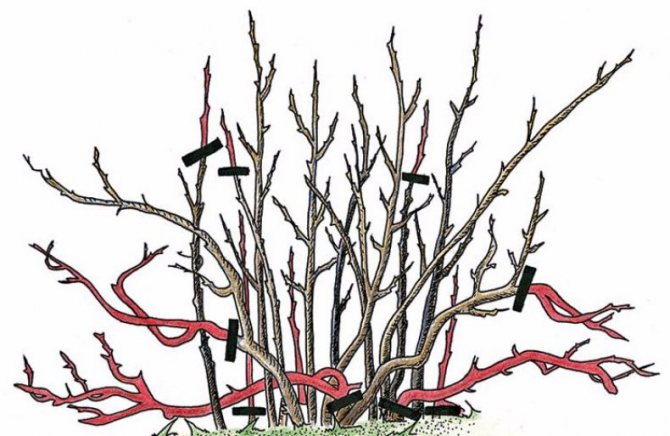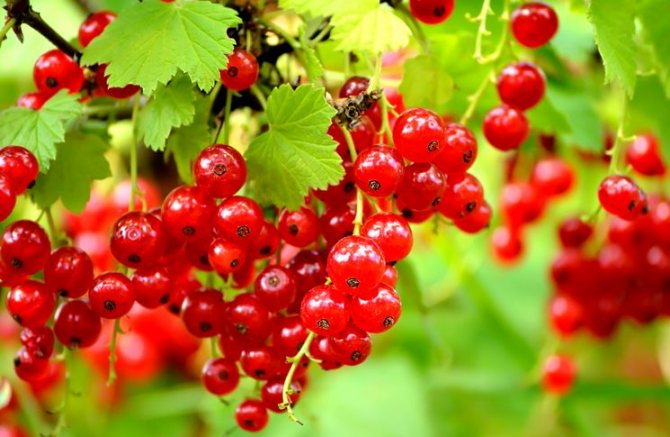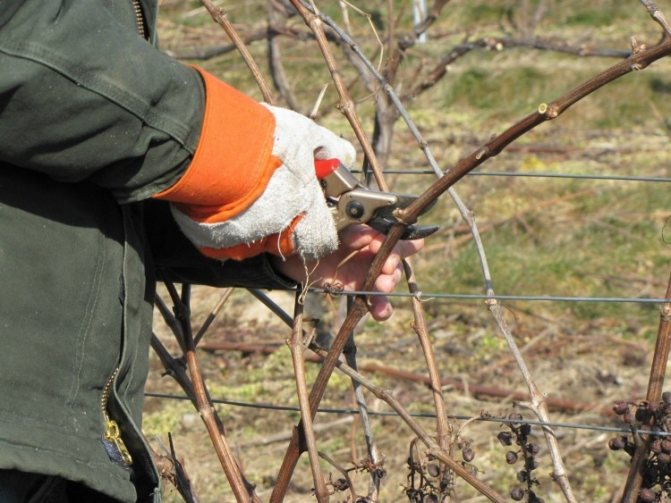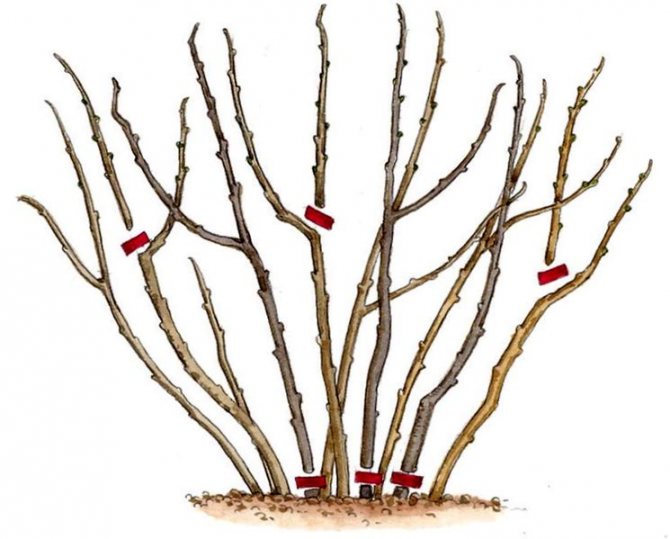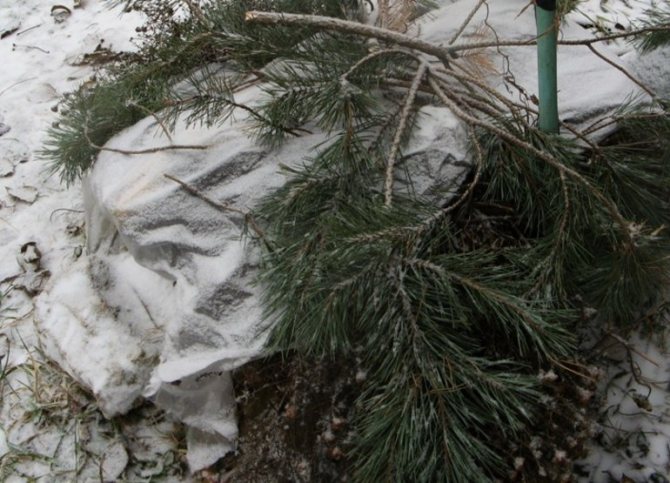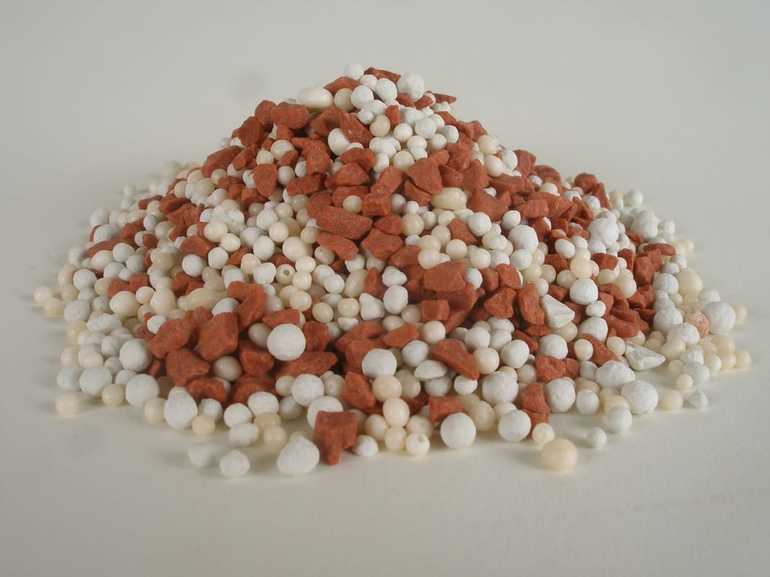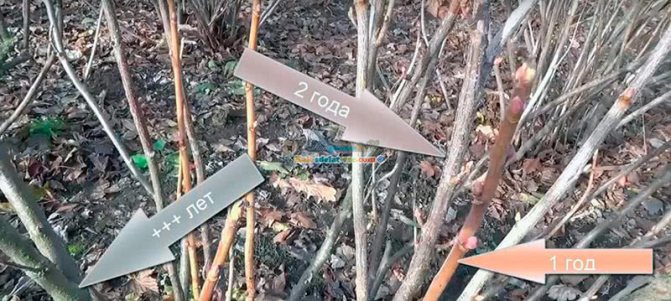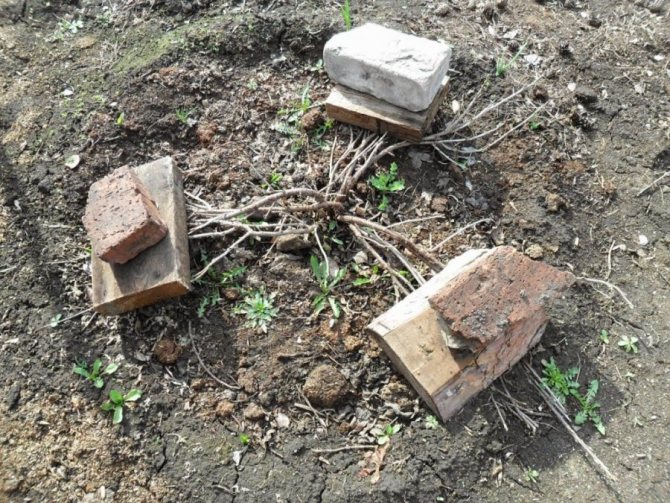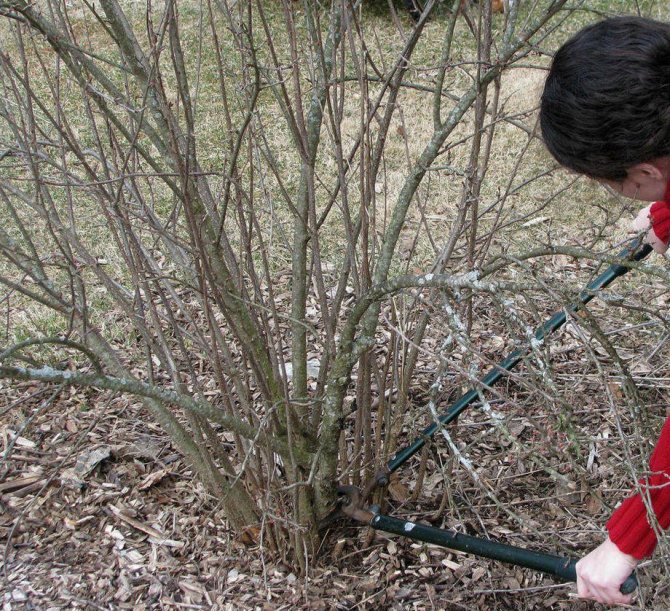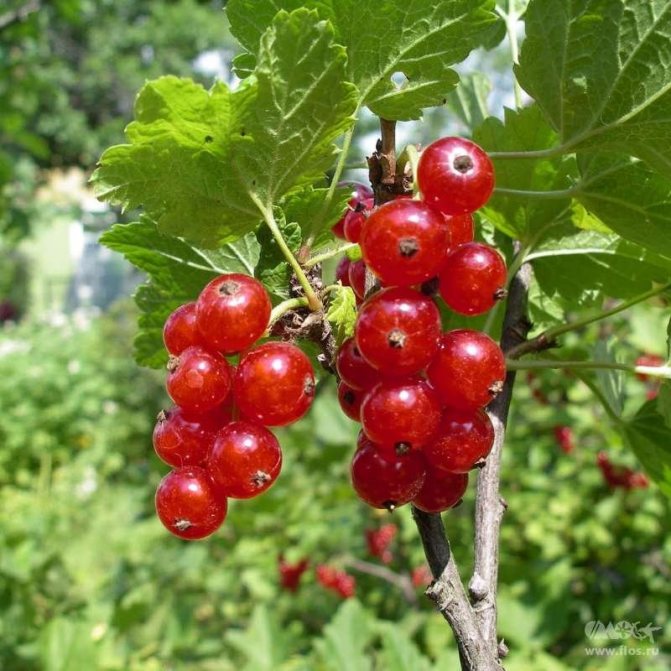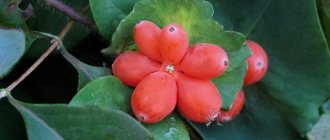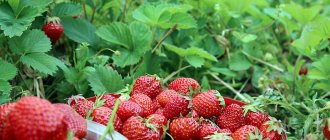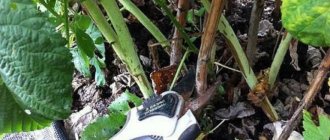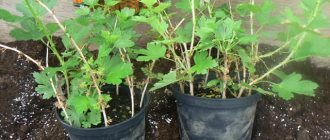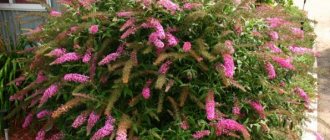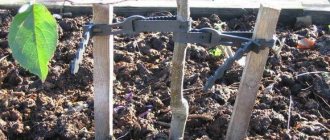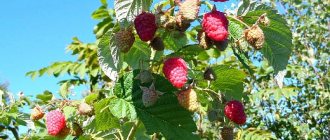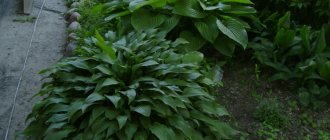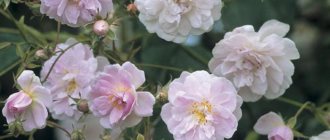After picking the berries, the fruit and berry bushes are restored and prepared for the new season. In July-August, buds are laid for the next year, therefore, it is during this period that attention is paid to currant bushes. Performing pruning and feeding in August and September is very important.
- 2 Watering and loosening
- 3 Fertilization
- 4 Pest control
Currant care in autumn
A tasty and healthy berry - currant, is found in summer cottages from southern latitudes to northern regions. This shrub is not picky about care, it can withstand temperatures down to 30 ° C and bears fruit for more than a dozen years. Caring for currants after harvesting comes down to a number of simple procedures:
- transplant if necessary;
- sanitary, anti-aging and formative pruning;
- cleaning and digging the trunk circle;
- abundant pre-winter watering and soil mulching;
- top dressing with potassium-phosphorus fertilizers;
- treatment with systemic preparations of fungicidal and insecticidal action.
How to feed currants in the fall?
In order for the shrub to winter well, gain strength for the new growing season, and give a good harvest next year, it needs high-quality feeding.
- Dry fertilizers are applied to the soil for digging, and organic matter can be applied after pre-winter watering.
- When choosing how to feed currants in the fall, you should give preference to potassium-phosphorus fertilizers.
- These can be industrial drugs: superphosphate and potassium sulfate.
- Compost works well from organic matter; 2-3 buckets can be safely added under each bush.
- Chicken droppings are applied as a top dressing only when the cold weather approaches, so that during the winter the nitrogen in its composition is dissolved in the soil. Then in the spring the plant will gratefully absorb the necessary nutrients.
- The introduction of industrial nitrogen fertilizers in the fall is unacceptable.
How to transplant currants in the fall?
If, for a number of reasons, the shrubs need to be relocated to a new place, then you need to know how to transplant currants without harm to the plant. A few weeks before the transplant, you need to prepare a new site:
- Choose a sunny, windproof plot. It will be good if potatoes, corn and beans were grown here earlier.
- Dig up the ground thoroughly and remove all weeds and their roots.
- Dig a hole 60x60x50 cm in size.
- Pour fertilizer into it from a bucket of compost and manure, 0.25 kg of superphosphate and 1 liter of wood ash. Mix everything.
- Leave the hole for 14-20 days.
The bush transplant technology itself is as follows:
- Two buckets of water are poured into the hole.
- At the bottom of the planting pit, a hill is formed from sod land.
- They carefully set the bush on the hill, spreading all the roots, and slowly bury the hole.
- The soil around the plantation is lightly tamped.
- The trunk circle can be mulched with peat or straw.
Shelter currants for the winter
This unpretentious shrub is able to withstand severe frosts down to -30 ° C, so if the climate is mild, currants can be left uncovered. If the winter is harsh, or unadapted imported varieties of berries are grown, then the question of how to cover the currants for the winter is fundamental for the survival of the bush. This can be done by bending the branches to the ground, using a load of wood or brick.You can cover it with straw, spruce branches and special breathable material for covering work.
Bending branches
When figuring out how to cover currants for wintering, it is important to pay attention to other points of this procedure. One of them concerns the bending of branches in order to protect against frost. After all, if some varieties can easily withstand 45-degree frosts, then the rest are affected even when the temperature drops to -5 degrees Celsius. In any case, even the most frost-resistant bushes are not immune from death in the absence of snow cover or prolonged exposure to a draft. Better to sacrifice a few minutes of your time and safely hide the culture. You need to do such manipulations with all varieties.
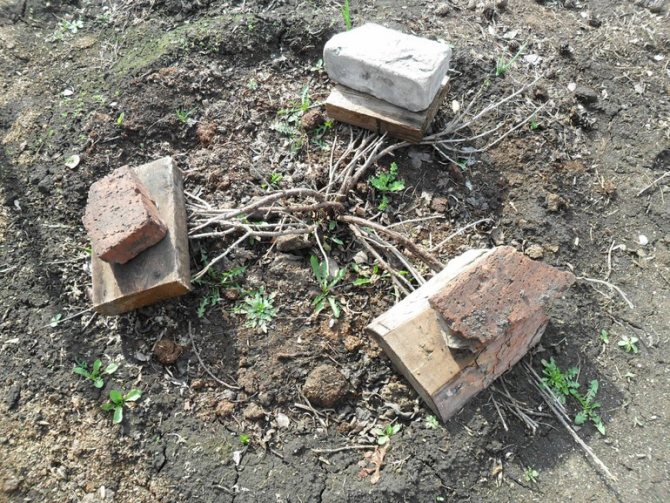
The bending of the branches is done in different ways. You can hammer a wooden stick in the middle of a bush and tie all the stems to it, and then wrap it with agrofibre or other insulating agent. And although this method is ineffective, it has a lot of advantages - the gardener does not need to spend time and effort on additional garden work. You can get by with one rod and one rope.
You can also bend the bush to one side, but you can start this action only with intensive movement of juices, since dry branches are subject to breakage. Experienced gardeners advise not to keep the plant under cover for a long time. With the arrival of spring warming, the insulating layer must be torn off or unwound so that the plant continues its normal development.
Important!
You can not bend the bush too early before the final leaves fall. Otherwise, fungi and various parasites will begin to appear on them. Improper care will also contribute to this.
Caring for red currants in the fall
The main measures for caring for currants are standard for each variety. Differences begin in the pruning process. Caring for red currants consists in maintaining the optimal number of young one-year-old shoots, because fruits are formed on them. They do not need pruning for lateral branches to grow. The optimal number of fruiting branches is 15. The rest need to be pruned without leaving the hemp. You can increase the number to 18-20. With a large number of young branches, the yield will be less, and the berries themselves will be small.
Pruning bushes
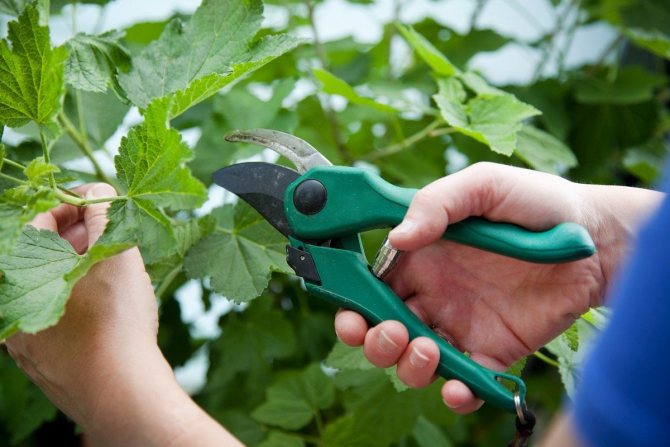

After harvesting from the currant branches, sanitary pruning is carried out. The procedure is carried out using a secateurs. Remove from the bushes:
- all diseased shoots;
- damaged branches;
- old branches that are covered with bloom and have acquired a brown color (they will no longer bloom);
- excess basal processes;
- branches falling to the ground.
Powerful shoots that have formed in the current season are pruned by 5-8 cm. After the shearing is done, excess ballast disappears from the currant bush. All his energy goes into planting the kidneys for the next year.
On black currant, leaves are harvested by hand, especially yellow and diseased ones. And for red currants, this procedure is not suitable. So that the bush does not experience unnecessary stress, the leaves should fall off the red currant on their own.
On a note! Healthy branches can be selected from cut off shoots for further use. They are used for germination and further planting, and also teas are prepared from them, added when canning.
Caring for black currants in the fall
According to a different principle, black currant bears fruit. Berries are formed on shoots that are 1, 2 and 3 years old. It is important that their number is the same. Caring for black currants is reduced to pruning zero shoots and root shoots. The formed branches must be pinched to stimulate the growth of lateral shoots. For the rest, top dressing, watering, transplanting and shelter for the winter for black currant is identical to its other species.
Currants in the fall, leaving, pruning, feeding which will be within the power of even a beginner in gardening, enters a state of dormancy and gains strength for the next growing season.By correctly carrying out all the preparations for winter, especially pruning, depending on the variety, you can ensure yourself a bountiful harvest for next year. The main thing is not to deviate from the existing instructions.
The subtleties of trimming procedures
Preparing black currants for winter is more difficult than caring for red varieties. This is due to the early formation of fruits that appear already on 1-2 or 3-year-old shoots, which forces the gardener to equalize their number. Otherwise, the culture will cease to bear fruit normally and there will be no good harvest.
Every year new shoots and shoots are formed on the bush, in addition, there is an intensive development of the formed branches. The first copies are removed first, the second ones are trimmed for the purpose of clothespin the growth point.
To successfully prune a currant bush in the fall, you need to follow certain rules:
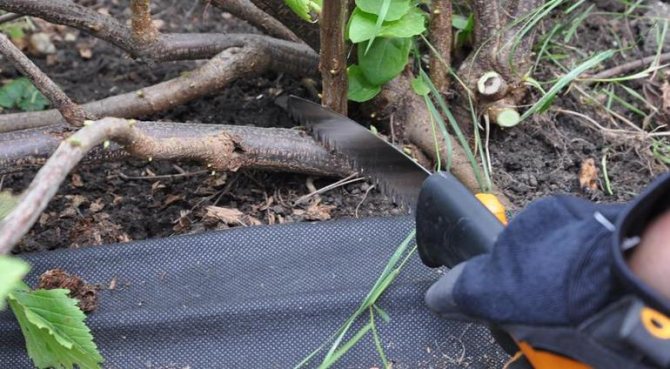

- Saplings at the age of one year give about one or two full-fledged branches, while there is practically no growth on them. With the arrival of the autumn season, it is necessary to pinch the growth point so that the next year the stems begin to grow to the sides and give much more fruit. The procedure is best performed at the end of autumn, when sap flow and other processes in the culture are suspended.
- As the root system grows, the number of growths increases several times. It is important to cut off such elements at the root, since they are not able to withstand the winter and will take away the useful vitality of the plant. Experienced gardeners recommend forming no more than 18 stems - in this case, the size of the berries will be extremely large, and the taste will be sweet and well-ripened. A strong overgrowth of the crop is accompanied by a low yield, so pruning must be approached with all responsibility. In addition, it is necessary to pay attention to the one-year branches from last year's shoots - in this case, you should carry out the clothespin of the tops, aligning them in height with the old ones.
- In the third year of pruning, it is necessary to remove the “hat” from the berry crop. To do this, the gardener removes dead, diseased and old stems on which all kinds of fungi and other diseases develop. When processing three-year crops, it is necessary to prune them directly at the root and then burn the branches. Young shoots that did not have time to ripen and become stiff can also be removed, since they cannot survive the winter and colonies of bacteria and parasites develop in them.
Currants in the fall: planting and care, pruning in the fall and transplanting
Everyone knows that currant berries are not only tasty, but also healthy. For the human body, currants are a storehouse of vitamins, essential elements and organic acids, and if you want to harvest a high yield of currants every year, you need to take care of it, not only before and during fruiting, but also in the fall, after harvesting. In our article, we will share with you information about which month to plant currants in the fall, how to plant currants correctly in autumn, how to care for currants in autumn, whether to cut currants in the fall, and how to properly prepare currants for wintering.
Notes from experienced summer residents
- Currant is a self-pollinating plant. If you plant other varieties nearby, cross-pollination will occur, the berries will be larger;
- Black currants do not like acidic soils, so deoxidize the soil;
- Do not plant currants in lowlands with high moisture, it is unlikely that there will be a good harvest;
- The harvest of berries does not depend on the number of branches, but on the number of buds on them;
- The taste of the berries depends not only on the variety and care, but in many respects on the weather conditions. If the weather is cold during the ripening of the berries, then the fruits will be noticeably sour.
Read also: Golden currant - planting and care: advice from a SPECIALIST, Site about a garden, a summer residence and indoor plants
Dear Readers! Thank you for visiting me! I would be glad if you share in the comments your experience in growing vegetables, methods of combating plant diseases and pests. I really hope that we will communicate with you for a long time, there will be many more interesting articles on the blog. In order not to miss them, subscribe to the blog news.
Good harvests to you! Taisiya Filippova was with you.
How to plant currants in the fall
Planting dates for currants in autumn
The main question that a novice gardener needs to solve is: when to plant currants - in spring or autumn? You can plant currants in open ground during the entire growing season, however, in the spring, the buds of currants open too quickly, so you will have very little time between the moment the soil thaws and the beginning of sap flow in trees and shrubs. You may not be in time. Therefore, many gardeners prefer autumn planting, after leaf fall, when sap flow slows down and the plant is preparing to enter a dormant period. From a botanical point of view, there is no difference between spring and autumn planting of currants. The decisive factor in this matter is the climatic conditions of the region.
When to plant currants in the regions
The survival rate of currant bushes will be much higher if, after planting, you create the most favorable conditions for them, but the quickly onset of frosts will easily destroy the plant that did not have time to take root. It is also of great importance what type of currant we are talking about: red currants are much weaker than black in autumn and can easily die in winter, therefore, it is better not to experiment with rare varieties of this culture, but to plant them in the garden in mid or late March, as soon as enough the soil will warm up.
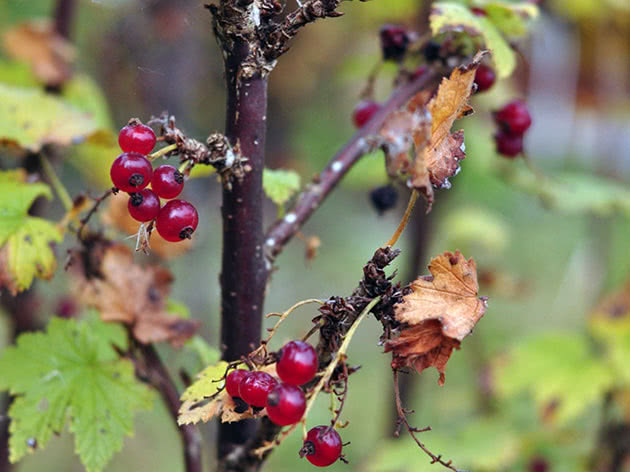

Black currants are not so weak in autumn and in areas where winter comes late, they have time to set up and develop a strong root system - for this it takes four weeks until the air temperature drops to 0 ºC. In the conditions of the middle lane, this occurs approximately at the end of October, therefore, it is necessary to plant currant bushes in the fall in the ground, for example, in the Moscow region, in September, in extreme cases, at the beginning of October.
In Siberia and the Urals, it is better to plant currants in the spring - the spring is long and wet there.
What to feed?
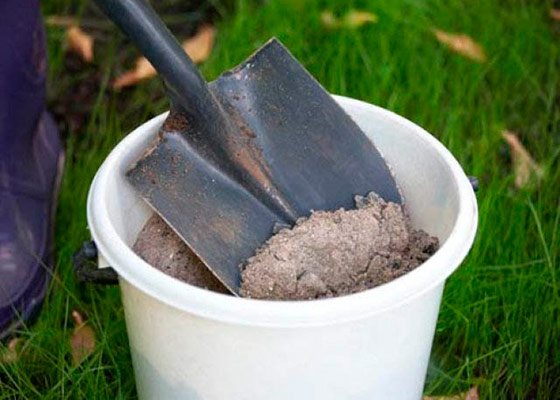

Fertilizer is an extremely important substance for the shrub. All the phosphorus, potassium and magnesium that the soil contains, the plant quickly draws out. So the autumn feeding must be done without fail, otherwise the bush may not only not bear fruit, but also die altogether.
The procedure for introducing nutrients:
- For berries: long-acting ingredients - potassium and phosphorus in granules. Affect the quantitative and qualitative parameter of the berries during the fruiting period.
- For growth: chicken droppings and mullein. They are also "long-playing", decompose in four months, but they will begin to act exactly at the moment when it is extremely necessary for the bush.
- For moisture retention: ash. With its help, moisture under the bush is retained, and in the spring the earth will not crack.
It is very important here to ensure that the fertilizer is not applied earlier than necessary, and in the amount indicated on the label.
Other rules for caring for a shrub:
- regular loosening;
- fertilization;
- weed control;
- pruning dry branches;
- renovation of old bushes;
- protection against pests.
Planting currants in the fall in the ground
Preparing currants for planting
High-quality currant seedlings should have ripe shoots and succulent roots. Tear off all the leaves on the seedling, and if the roots are dry, lower them before planting in a bucket with a solution of ground insecticide, for example, Aktara - this will prevent damage to the roots by gnawing insects (wireworms, May beetles and others).Before planting, seedlings with succulent roots are dipped in a mash, consisting of 3 liters of water, 6 g of Aktara, 1-2 bags of Kornevin, 1 kg of clay and 1 kg of black soil. The talkers made according to this recipe should be enough for 15-20 currant seedlings.
Then plant the currants
A plot for currants is chosen flat, protected from the wind, with the occurrence of groundwater no higher than 1-1.5 m from the surface - currants do not tolerate wet soil and prolonged stagnation of water. Not suitable for growing crops and areas overgrown with wheatgrass. The best predecessors for currants are vegetables and flowers, perennial legumes (clover and lupine), mixtures of cereals and legumes, row crops, and after such plants as gooseberries, currants and raspberries, currants cannot be grown.
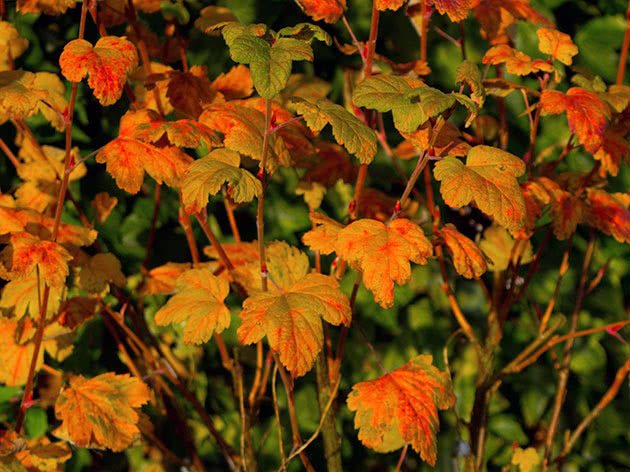

Soil for currants
The best soil for currants is light to medium loam and cohesive sandy loam soils. Clay soils dry out poorly in spring, there is little air in them, it is difficult to keep them in a loose state, therefore, plants develop on them very slowly. In sandy soils, on the contrary, there is too much air, they do not retain moisture well, and plants suffer from drought and lack of nutrition.
3-4 weeks before planting, a deep digging of the site is carried out with the removal of rhizomes of perennial weeds and subsequent leveling and loosening of the surface. For digging, add 6-8 kg of humus or compost, 40-50 g of superphosphate and 20-30 g of potassium fertilizer to each m² of the plot.
What pests and diseases are currants susceptible to?
Currants can be susceptible to disease. Among the frequent diseases on currants, it is necessary to highlight:
- Anthracnose - the disease manifests itself in the form of red spots on the leaves. Symptoms are observed in mid-summer, most often red currant varieties are exposed. The disease is of the fungal type and spreads rapidly among the bushes.
- Terry - manifests itself most often on black currant varieties. The cause of the occurrence is a bud mite that infects the culture, as a result of which the leaves and shoots mutate.
- Currant glass is a pest in the form of caterpillars, hibernating in the shoots. A butterfly emerges from the caterpillar, which in a short time lays the larvae in the bark of healthy bushes.
- The formation of bedbugs on the currant - the berry bug appears on the currant and sucks out the juices, which leads the plant to death.
- Scab formation on bushes is an infectious disease that damages leaves and shoots. It looks like dark spots that quickly increase in size.
- Marginal necrosis - the leaves of the plant die off and fall off. The disease occurs with an excessive amount of chlorine in the soil.
- Brown spot - appears in the form of brown spots on the leaves.
- Septoria is a fungal disease that affects fruits and leaves and manifests itself in the form of small brown spots.
- Goblet rust - appears in the form of bright yellow spots on the leaves, which gradually wither and fall off.
- Powdery mildew - forms a white coating on leaves and shoots. Reduces the growth of the bush and leads to its death.
- Currant leafworm is an insect that damages leaves and entangles them with cobwebs, leading to the death of young shoots and foliage.
- Aphids are small insects that feed on the sap of young shoots and leaves. It is formed in large quantities and in a short time leads to the death of the culture.
- Berry sawfly - damages fruit and causes rot.
There can be a large number of diseases and pests on currants. Therefore, cultures should be examined regularly for symptoms.
How to plant currants in the fall
How to plant currants in the fall
Planting holes about 40x40 cm in size and 30-35 cm deep are dug two weeks before planting. Three-quarters of them are filled with soil from the top layer and left in such a way that the soil settles. How to plant currants in the fall? Before planting, the shoots of the seedling are shortened to 15-20 cm, and the roots are dipped in a chatterbox, then the seedling is placed in the planting hole at an inclination of 45 º so that it is 6-8 cm deeper underground than it grew in the nursery. Shoots are fan-shaped.
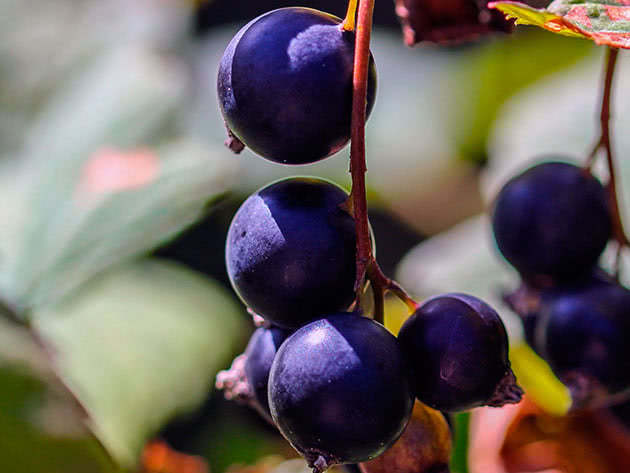

Fill the roots of the currant with fertile soil, compact it, make a hole around the perimeter of the root circle and pour a bucket of water into it. When the water is absorbed, cover the tree trunk circle with humus, peat or dry sand.
Usually currants are planted in rows, keeping the distance between bushes 1-1.25 m, and between rows 2.5-3 m. For the most part, currants are self-fertile culture, but cross-pollination increases yields, so plant several inter-pollinated varieties on the site in separate rows.
Processing older bushes
In the fourth, fifth and all other years of the life of currant bushes, pruning is carried out by pinching the growth point and removing dry shoots. If, after reaching the age of five, the culture ceases to bear fruit, during the autumn care you will have to cut out 5-year-old shoots.
When pruning red varieties, you must adhere to different principles and follow certain rules. Pruning such a crop is a little easier due to its nature. Such bushes begin to bear fruit already from the first year of life, therefore, it is not necessary to pinch annual branches. All other trimming steps are practically the same. The formation of an adult bush occurs in the same way as in the case of black currant, only it becomes much higher.
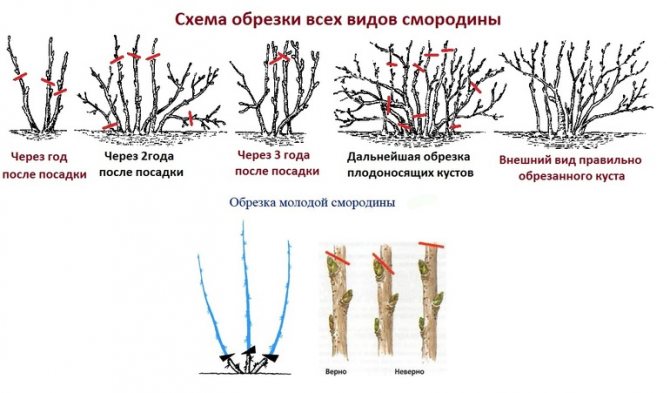

Important!
The optimal number of branches reaches 20, but fifteen can be used to reduce the load on the plant. It is also important that the culture gets enough nutrients, oxygen and minerals. If they are not enough, the fruits will become not only small, but also rare.
Trimming works in autumn track not only the aesthetic goal, but also the nutritional, being a good way to increase fruiting. High-quality pruning of the top of the bush protects the crop from various diseases and pests, because most insects and fungi settle in the upper part of the plant. If you do not cut them before the beginning of winter, there will be a risk of damage to the currants in the spring. As a result, the gardener will have to spend a lot of time and money on the treatment of leaves from stains, fungi and viruses.
When performing a cut, it is necessary to observe accuracy and use a quality tool. Any inaccuracies will cause irreparable harm to the bush, lead to long healing of wounds and halt the development of the plant. The pruner you use should cut the paper with ease - in this case, it is suitable for processing the crop.
If we talk about the timing of garden activities, then they are determined by the geographical location and climatic conditions in which the culture grows. Gardeners from mid-latitudes can insulate the bush from November 15 to 20, when sap flow in the branches stops. It is advisable to have time to complete the procedure two weeks before the onset of frost and no later.
Transplanting currants in the fall to a new place
When to transplant currants in the fall
Black currant bushes are cultivated for up to 10 years. Of course, with good care, they can bear fruit longer, but the yields will gradually begin to decline, the quality of the berries will deteriorate, and the size will decrease. The still old bush needs to be dug out, divided, and those parts that are younger and more promising should be planted in a new place. When to transplant currants in the fall? The currant is transplanted at the same time as the primary planting - after the end of the growing season, when the bush will drop all the leaves.
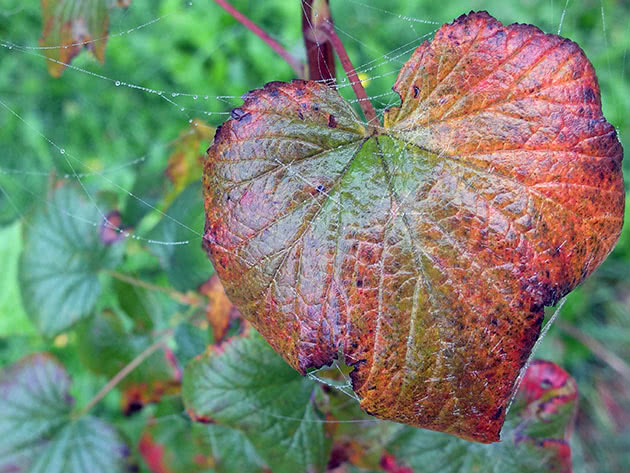

What to trim?
The secateurs should be well sharpened and sharp. If you don't have one, you can use a garden saw. It is imperative to remove all branches that are already very old, as well as those that do not bear fruit.Inspect root shoots and remove excess. If damaged and diseased shoots are seen, they also need to be cut off. And, finally, those twigs that either grow too close to the ground, or interfere with the normal development of "neighbors".
All that was cut off must be immediately removed from the ground and burned.
Currant care in autumn
Caring for currants in the fall consists of such procedures as watering, weeding and loosening the area, pruning, treatment from pests and diseases, and preparation for wintering. But there is a big difference between caring for mature bushes and seedlings. So, how to care for currants in the fall so that they take root successfully?
Watering currants in autumn
At first, currant seedlings need abundant watering - the roots are literally kept in water, like rice. After two weeks, watering becomes less frequent and plentiful. For adult bushes in dry autumn, they carry out podzimny water-charging irrigation - 3-5 buckets are poured per m² of the plot in order to soak the soil 40-50 cm deep. How much moisture the currant receives in the fall depends on its cold resistance and the next year's harvest.
How to feed currants in the fall
Fertilizing currants in the fall is done so that they can survive the winter without harm to health. However, when planting, such an amount of organic matter and minerals is introduced into the soil, which will be enough for seedlings for more than one year, so you can skip fertilizing currants in the fall.
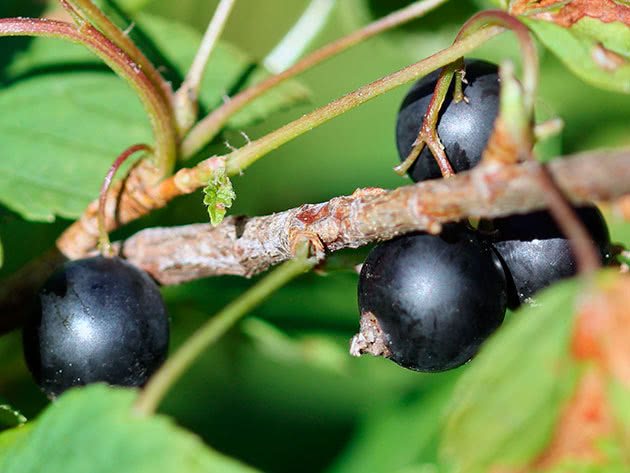

Processing currants in autumn
Many insect pests and pathogens overwinter in the upper layer of the soil, and with the onset of spring they begin their harmful activity in the currant. How to treat currants in the fall from diseases and pests? Spraying the bushes and soil under them with a 7% solution of Karbofos is effective against insects, and against diseases - with a 1% Bordeaux liquid. Before processing, it is necessary to remove fallen leaves and debris from under the bushes.
Pruning currants in the fall
On our website you can find detailed information on how currant pruning is carried out in the fall - for beginner gardeners. But pruning currant bushes in the fall and pruning freshly planted cuttings are not the same thing. How to prune currants in the fall if they are in the process of rooting? It is only necessary to shorten the stems of the plant, leaving shoots 3-5 buds high on the bush.
Currant mulching
Currants are mulched immediately after planting in the ground and the first watering. Used for mulch, humus, peat or fallen leaves. The thickness of the mulch layer must be at least 7 cm.
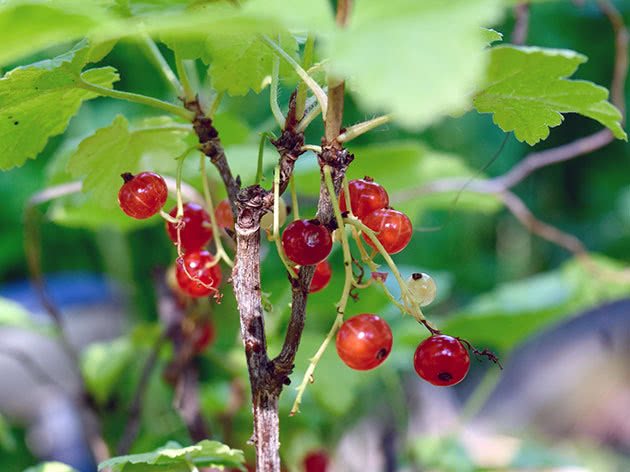

Pruning in the fall
Autumn pruning is necessary for the following reasons:
- with adequate nutrition and space, healthy plants tend to grow vegetative mass even at the expense of generative bud growth. A large currant bush without berries is unlikely to please anyone;
- removal of affected and dried-up branches reduces the possibility of wintering various pests and pathogens, this event also contributes to increased flowering;
- makes the bush more compact and improves its appearance.
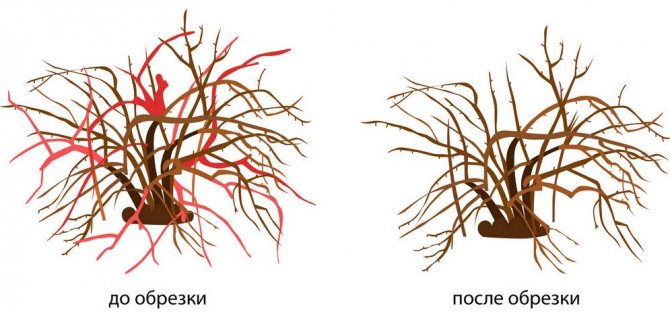

Optimal timing
Currant pruning can be carried out both in spring and autumn. But this process must be carried out while the sap flow is stopped, otherwise it threatens with disease or even the death of the plant. And since the currant wakes up from hibernation very early (approximately at the end of February), then in the spring it is not always possible to cut it off in time. In the fall, when the shrub is preparing for winter and sap flow is suspended, the interval when the shrubs can be pruned is much longer. This occurs in the period after leaf shedding and before the onset of persistent cold weather, that is, in late October or early November.
Important! Bushes should not be cut too early, as a significant number of branches are cut, and this is a great stress for the plant. But it also makes no sense to pull until frost.
Trimming scheme
At different stages of growth and at certain periods, currants need different pruning, which is:
- sanitary - required for thinning the bush and getting rid of stems affected by pests and diseases;
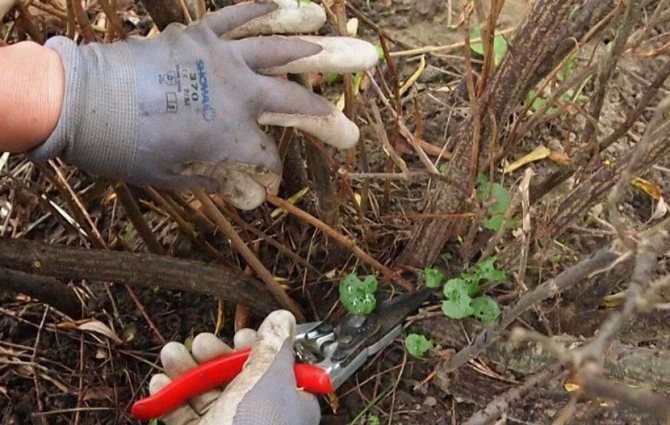

- formative - it is necessary for the formation of the correct crown in order to further obtain bountiful harvests, as well as to simplify the collection of products and care for the bush. Giving the desired shape to the crown, they optimize its structure using branches of different ages. The most expedient form of a bush is a bowl with an open central part;
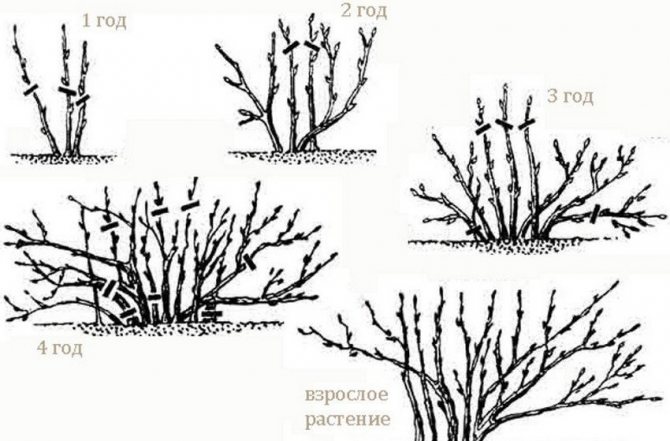

- rejuvenating - elimination of old unpromising branches. This serves as a stimulus for the growth of young shoots. Blackcurrant branches over 5 years old stop fruiting and only take food from young branches. For red and white varieties, such branches are those that grow for more than 6-8 years;
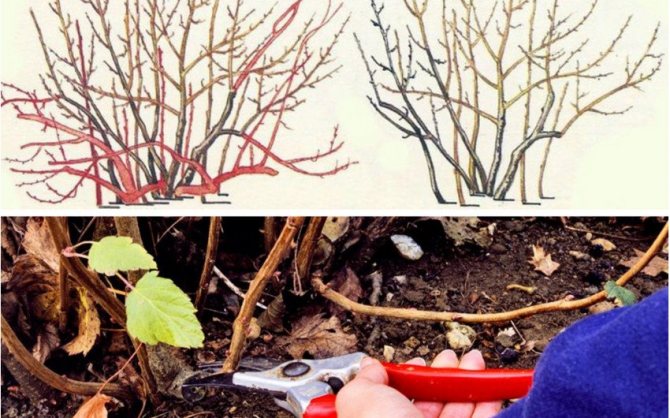

- pinching the top shoot causes active growth of lateral processes.
Important! If, during pruning, a black hole is found on the cut, then such branches are removed and burned. This fact indicates the presence of a dangerous pest of glass, which affects not only currants, but also other shrubs.
To summarize, it turns out that autumn pruning involves removing:
- old shoots. An exception may be the case when such a branch is well located and, in comparison with others, is still productive. In this case, it can be left for another year;
- sick or weak shoots. Despite even their young age, they do not need to be left, as they will be unproductive;
- extra stems. Of the young (annual) shoots, only about 6 of the most developed ones are left. All others must be removed right at the base. Without regret, you need to cut off all branches lying on the soil, as well as those that form an angle with the ground less than 45 °.
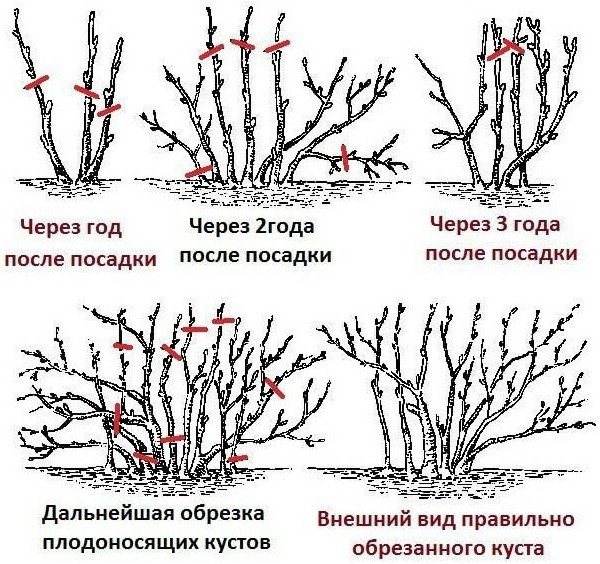

Subject to all the rules for pruning, a properly formed plant should have from 10 to 15 branches of different ages:
- one-year-olds - 4–6 pcs .;
- two-year-olds - 2–4 pcs .;
- three-year-olds - 2–4;
- four-year - 1-3 pcs. for black, 2–4 pcs. for red and white;
- five-year-olds - 1-3 pcs .;
- seven to eight years old (for red and white) - 1-3 pcs.
Video: How to properly cut currants
What to do with a young bush
Young currant bushes are formed annually according to the following scheme:
- when planting a seedling, all its branches are pruned to 2 or 3 buds. This will stimulate the plant to form 5-6 young shoots;
- in the 2nd year, all weak branches are removed and from 3 to 5 of the most powerful ones are left, which in the future will become the "skeleton" of the future bush;
- the above is repeated with a three-year-old shrub. That is, about 3-5 strong and correctly placed annual branches are left;
- on the 4th year from the moment of planting the seedling, everything is repeated again.
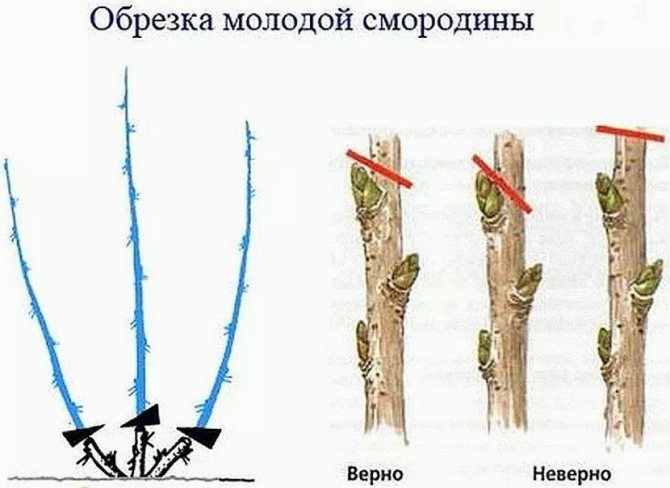

During pruning, a large amount of branches are removed, which is stress for the plant. To reduce it a little, it is necessary to use well-sharpened tools (pruning shears or a hacksaw).
Rejuvenation of the old bush
With annual formative pruning, currant bushes have a fairly compact and well-groomed appearance. But, as already mentioned, five-year-old shoots in black currants and six-seven-year-old stems in white and red ones lose the ability to bear fruit. Therefore, they are removed along with damaged, dry and weak branches.
You may be interested to know what to do when the currant branches dry up.
With such a rejuvenating procedure, the branches are cut at the very root along with the shoots (tops). IN As a result, pruning five-year bushes looks like this:
- on 2–4-year-old stems, 3 or 4 buds are left, and the rest is cut off;
- on last year's shoots, the tops are pinched;
- up to 5 powerful shoots are left from young branches (of the current year), and all the rest are cut out.
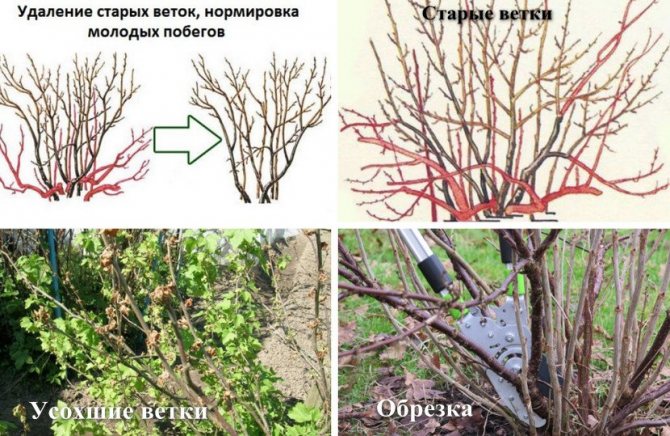

If the formation of the crown was not carried out from the very beginning, then the plant becomes not so much fruitful as decorative. But this is not at all a reason to get rid of it. You can rejuvenate the bush:
- all diseased and dried stems are initially cut out;
- all stems in contact with the ground, intertwining or growing inside the bush are also subject to cutting;
- then old (more than 5 years old) branches are cut out. They are easy to distinguish by their dark brown color (young ones are light gray or yellow in color);
- if weak replacement shoots prevail on old bushes, then all old branches should not be removed. Of these, you need to leave those that have an increase of at least 10 cm and large flower buds. These branches are shortened to a strong lateral branching, which will cause strong formation of young shoots the next year. After that, for the next fall, it will be possible to remove the old branches left, and leave the young ones.
You may be interested in how to make a currant bush holder.
The rejuvenation procedure can take 2-3 years until the bush consists of only promising fruiting branches. In the future, every year all the stems are shortened at each branch, leaving from 2 to 4 buds. In annual shoots (about 50 cm), the tops are cut off, and about 5 of the strongest are left from the stems of the current year.
When pruning, remember:
- old branches are cut almost at the root, leaving a stump of no more than 3 cm. If you leave more, "tops" (unproductive branches of an old branch) can form;
- cuts need to be treated with garden pitch to prevent infection with diseases;
- for red and white currants, branches older than 7-8 years of age are considered to be infertile;
- you cannot cut too many branches, the plant will hurt and may even die. After the procedure, at least a third of the initial volume of the plant should remain.
Video: How to rejuvenate an old currant bush
What to do with currants in the fall to have a good harvest
Outwardly, the currant looks like a sturdy shrub, which, as it seems, can survive drought, attack of parasitic insects and pests. But for this she needs some care from the gardener. And this applies to black, red and white currants.
Autumn care has its advantages. At this time, most of the work on the land plot is reduced, and a person has time to deal with currants. Typically, care consists of the following:
- Top dressing with organic and mineral substances.
- Processing a plot of land around the bush.
- All types of pruning - formative, rejuvenating and sanitary.
- Watering.
- Processing currants from pests and diseases.
- Mulching.
Completion of all stages of work in the autumn is a guarantee of successful wintering. Care is a kind of help for gaining strength, laying fruit buds and entering the sleep phase. In order for the currants to give a rich harvest from year to year, one should not forget about carrying out autumn work.
If the plant requires a change of location
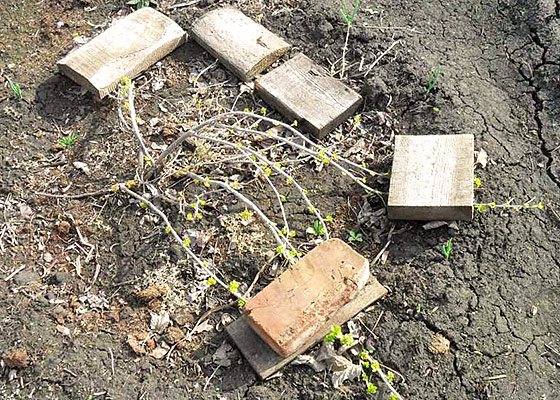

A fall transplant for black currant can be a good option - it doesn't really matter what season it is in. But a bush of red berries does not need to be touched before frost - it will simply die without rooting in a new place.
The soil should not be too wet. If an excess of water was noticed, for example, it rained after watering, then it is better to let it dry a little.
How to properly care for red and black currants in the fall
The dates for the maintenance work fall at the end of October and the beginning of November. Currant is a shrub that wakes up in early spring.
In order not to harm her, it is necessary to have time to complete all the work in the fall.
Before proceeding with pruning and other procedures, it is important to make sure that the crop has stopped sap flow.
Shaping and rejuvenating pruning
The first on the list of maintenance jobs is trimming.Neglect of this procedure turns into a change in the size of the berries for the gardener. They are getting smaller every year.
Pruning begins by removing old branches containing small fruits. The bush is thinned out from branches, the growth of which is directed towards the very center. It is important to get rid of them, as they thicken the bush.
Broken and weak branches with few shoots are also cut off. As a rule, no more than 6 branches are left on one bush, the minimum amount is 4 pieces. In the next season, pruning is repeated, leaving only 3 branches on the bush. Because currants are a bushy shrub, pruning correctly will make it easier to care for next fall.
Watering
A young bush needs a lot of moisture. One crop requires 2 to 6 buckets of water. In rainy, cold autumns, watering is not required, provided that the trunk circle is well covered with mulch.
On average, gardeners use up to 6 buckets for watering one bush. You may also need only 3 buckets. It all depends on the composition of the soil and its ability to pass moisture. Water should penetrate 30-55 cm deep.
Black currants are not watered at the root, as this harms the underground part. At a distance of 10-20 cm around the bush, grooves are pulled out to a depth of 13 cm. When watering, water is poured into them.
Top dressing
The following fertilizers are used:
- substances based on potassium and phosphorus;
- compost;
- cow dung;
- chicken droppings.
Fertilizers are applied to wet soil. Therefore, feeding is carried out after watering.
Mulching
After pruning, watering and fertilizing, they proceed to work with the trunk circle. It needs to be mulched. For this, hay, leaves of trees or shrubs, as well as compost are used. In the latter case, it can serve as a fertilizer. The mulch layer should not exceed 10 cm.
Rotten sawdust is also a good mulch. The grass that remains after cutting the lawn is also used as a protective layer. If a person has chosen leaves and branches of bushes or trees, they should not be fruit. They give preference to decorative types.
We process the bite zone
The plot of land around the bush is freed from weeds, fallen leaves, various branches and all sorts of "debris". All this is burned, getting wood ash, which in the future may be needed when carrying out garden work. If the surface is clean, the soil is dug to a shallow depth.
Just 6-8 cm is enough. This will not damage the root system of the shrub, but it will turn pests onto the surface, which will freeze in winter and will not be able to spoil the harvest in the next season. Digging enhances water and air exchange of soil. In the fall, the roots continue to absorb moisture and accumulate it in the tissues. In turn, this will help the currants survive the winter and avoid moisture evaporation from the branches that are located on the south side.
Plant transplant
Old bushes are transferred to a new place. Regardless of the type of shrub, the procedure takes place exclusively in the fall. Throughout the winter, the soil settles and compresses. Thanks to this, the seedlings will grow quickly in the spring. If the transplant conditions are met, the shrub will develop correctly.
Preventive treatment
After mulching, the currants are observed. When all the leaves fall off the branches, preventive treatment is carried out. An excellent remedy for fungal diseases is Bordeaux liquid. The dosage of the drug should be within 2-3%.
Processing is carried out only after most of the leaves have fallen - about 85%. The remains are collected by hand. In no case should it be used as mulching. The leaves are burned along with the cut branches.
For maximum effect, each branch and even the trunk circle are sprayed.This approach also helps to clear the soil from pests, since when spraying, part of the substance enters the territory of the trunk circle.
How to process?
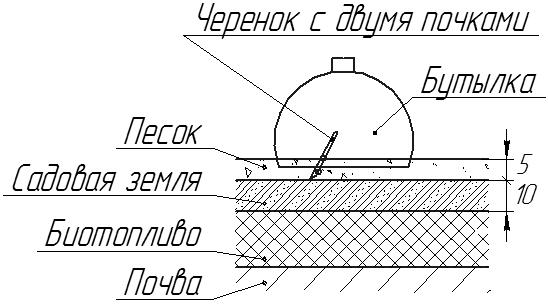

Some believe that digging up tree trunks is only harmful to the plant, and suggest mulching. This will not damage the roots of the shrub, and the soil will remain moist and loose.
Others, on the contrary, believe that the land under the currants must be dug up without fail - otherwise there is no way. Moreover, if you turn off the layer, all pests wintering there will be destroyed.
But there is also a third type of gardener. They argue that it makes no sense to leave the trunks at all. Therefore, in such people, the soil under the bush is sown with lawn grass. In this case, harvesting in the fall is easier - cleared of leaves, and you're done. In recent years I have been doing just that - both conveniently and beautifully.
There are three options to choose from, and which is the best one for everyone to decide.
How to prepare currants for winter
In addition to classic works, currants need a number of additional procedures. We are talking about adding soil and bending branches. If the branches are well covered, they will not be damaged during the winter. Shrubs growing in the Urals especially need this.
Adding soil
After dressing, currant bushes must be examined. They could be washed out after watering or as a result of precipitation. Sprinkle the bare place with earth, compacting it with a shovel. To exclude the formation of voids, the place is additionally compacted with feet.
The soil for filling is prepared in advance. Ash, earth and wood soot are mixed in equal amounts. Instead of the last component, furnace soot is taken. If it is not possible to prepare the mixture, use ordinary soil taken from the garden plot. The bedding layer should be around 10 cm.
Bending branches and covering them for the winter
Preparing currants for winter necessarily includes this stage. Shrubs can easily endure the winter period if the air temperature is not lower than -25 ° C. With more severe frosts, the branches die off, and the amount of the harvest in the next season is automatically reduced. But with proper care, currants will withstand temperatures of -50 ° C.
The shrub will survive the winter if the branches are pressed to the ground. This is done in several ways:
- The bush is pressed down with a heavy stone or brick. It is not recommended to lay all branches under one brick. They are distributed between 5-6 stones.
- Wrap the branches with frost-resistant material. Each is individually wrapped with agrofibre. As a result, the currants will withstand temperatures down to -40 ° C. Polyethylene is categorically not suitable as insulation, since the plant will not be able to breathe and will die. When growing shrubs in regions with severe winters, mineral wool is used together with agrofibre.
- Burying the bush into the soil. The earth is a wonderful insulation. Under a layer of earth, the shrub will withstand temperatures down to -35 ° C.
Wrapping currants with agrofibre is especially important in snowless winters. In this case, each branch is covered with a cloth separately.
It is not recommended to cover the whole bush with agrofibre together, as this will not provide the plant with adequate protection.
When a large amount of snow falls, a snow cushion is made at the base of the bushes. Its height does not exceed 10 cm. After that, the bush is completely covered with snow, and it will definitely survive the winter without problems.
Winter care and preparation
To obtain high-quality and plentiful harvests, autumn care for currants is not limited to pruning. Further, in detail about what other activities need to be carried out in the autumn.
Top dressing and bedding
During the growing season, plants consume a large amount of macro- and microelements that need to be replenished with the help of fertilization. It is necessary to figure out what kind of substances plants need in the fall, and why they are needed:
- nitrogen fertilization during this period is not applied, since they cause strong growth of shoots, which reduces winter hardiness;
- ash is a valuable fertilizer, which, in addition to potassium and phosphorus, contains a large set of other trace elements. But its main advantage is its good digestibility by the plant. The optimal dose for each bush is 3 glasses;
- if organic matter is introduced in the form of compost or humus, then this should be done before frost (November), so that it gradually gets into the soil until spring and is absorbed by the plant at the beginning of the growing season. Organic matter is introduced into the trunk circle in the amount of 4–6 kg for each plant;
- potash and phosphorus fertilizers are used in the form of potassium sulfate and superphosphate (introduced in the form of granules for digging). In the future period of fruiting, they will increase the quality and quantity of the crop.
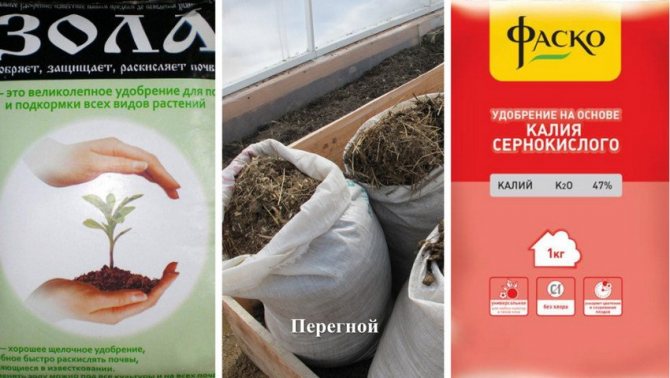

Depending on the type of soil, a different amount of potassium and phosphorus is introduced under each currant bush:
- On fertile loams, 40 g of potassium sulfate and 100–130 g of superphosphate are introduced every 2 years.
- Peat-bog soils are fertilized every 3 years (40 g of potassium sulfate, 150 g of superphosphate and 0.5 kg of lime).
- Sandy and sandy loam soils are enriched after a year (50 g of potassium sulfate and 150 g of superphosphate).
In addition to feeding, it also does not hurt to add soil around the bushes. For each instance, on average, you will need about a bucket of peat or sawdust. The layer should be up to 10 cm thick.
Did you know? Rarely can you find golden currants on the plots. Her most interesting thing is observed during maturation.
—
on the bush, you can simultaneously see fruits of black, brown, orange, pink and purple color
.
Watering
If autumn turned out to be dry or with insufficient precipitation, then it is necessary to carry out water-charging irrigation. This procedure must be done for several reasons:
- the trunk circle is moistened to a depth of 80 cm;
- during sudden thaws, the moist soil thaws out gradually and does not freeze sharply during a cold snap, which protects the plant from stress;
- watering has a beneficial effect on the growth and development of roots.
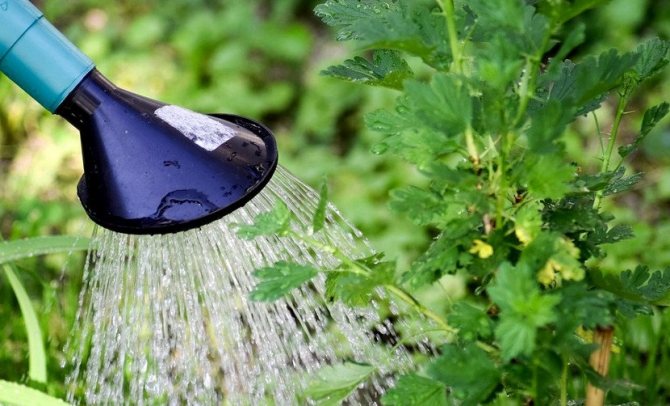

When watering, you should adhere to certain rules:
- each instance consumes up to 40 liters of water;
- watering is carried out in several stages (2-3 times with an interval of several days), since sharp moistening can provoke rotting of the roots;
- do not water with cold water, because it causes the formation of voids in the soil, which subsequently freeze, and this is detrimental to the roots;
- watering can be carried out immediately after harvest. In Siberia and the Urals, it occurs in September, and in the South, it is October.
Pest control
Most of the work to combat diseases and pests is carried out in the spring, but after the autumn pruning, preventive treatments can also be carried out:
- for spraying, a 1% solution of Bordeaux liquid, "Fitoverm", "Aktara", "Fitosporin", "Skor" and other similar preparations are used according to the annotations indicated on the packages;
- the bush is abundantly sprayed with a prepared urea solution (300 g / 10 l);
- the soil under the bushes, at the discretion, is watered with a light pink solution of potassium permanganate, a 1% solution of Bordeaux liquid or copper sulfate.
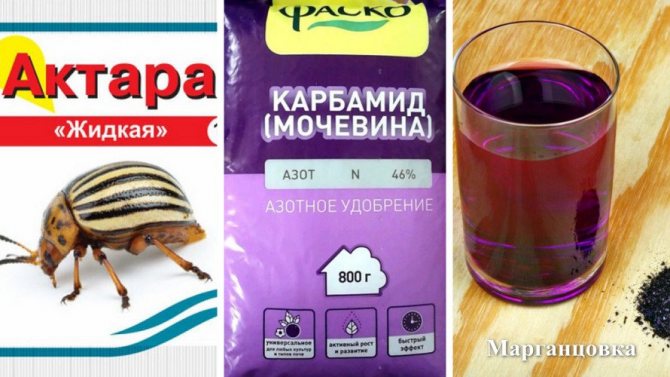

Bending branches
Currants are frost-resistant plants, but thaws and icing of the branches can negatively affect the plant and the future harvest. For this reason, when preparing plants for winter, bending and warming the crown of the bushes is practiced. There are several ways to tilt branches to the ground:
- collect the stems in a bunch and tie a brick or large stone to the top. Then bend the beam gently to the side and to the ground. Conduct this event before the branches become brittle (end of October);
- drive a rod in the center of the bush, and wrap the whole plant with agrofibre. After a cold snap, the bush bends down to the ground and sprinkles with soil;
- bend 1 or 2 branches to the ground in different directions and press down with bricks, pieces of slate or other suitable material other than iron.
Video: How to prepare a currant bush for winter
Insulation of the bush
In Crimea and other regions with warm winters, there is no need to insulate currant bushes for the winter. After pruning, they can simply be bent to the ground. In cooler regions, many European varieties are at risk of freezing. For this reason, it is recommended to insulate them, which can be done in several ways:
- after bending down, cover with spruce or pine branches, or any non-woven covering material;
- a good option is a removable frame that can be easily removed during a thaw;
- small bushes can be covered with boxes or burlap.
Warming is carried out taking into account climatic features and varietal characteristics.
Did you know? Currant berries have different colors: black, yellow, red, etc. But recently varieties with ripe green berries have been developed.
Treatment of the bite zone
Opinions on the treatment of the area around the bushes are fundamentally different:
- adherents of traditional farming methods argue that digging is required. Moreover, it must be carried out with the overturn of the earth layer. This, in their opinion, contributes not only to loosening, but also the death of pests and larvae wintering in the ground;
- proponents of organic farming argue that digging only harms plants, damaging small roots. Alternatively, they offer mulching;
- there are those that do not leave near-trunk circles at all, sowing this area with lawn grass. In this case, processing is simply raking up fallen leaves.
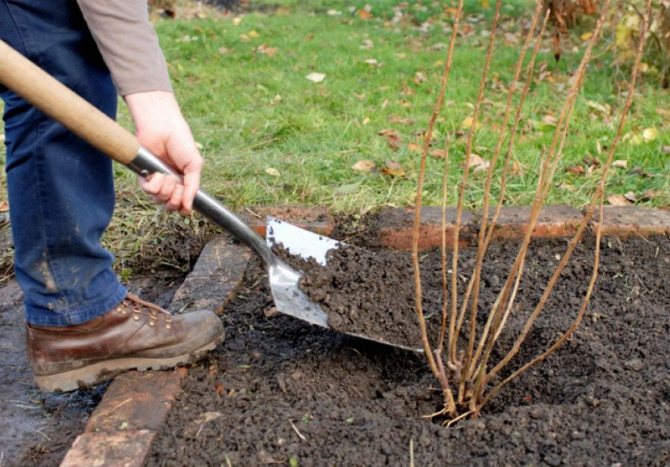

It is good if the information provided on how to care for currants in the autumn period becomes useful and helps to achieve abundant and tasty harvests.
Red, black, white, gold - differences in care
Autumn care for currants is the same for each species. The only difference is when the crop is cared for. Depending on when a particular variety begins to bear fruit, watering, feeding and autumn pruning occurs a week earlier or later. As a rule, gardeners combine grooming work.
Summer residents are trying to have time to carry out pruning before the onset of winter frosts. If this is not done on time, then the currants may die during wintering. At first, it is difficult for beginners to determine when to prepare a plant for winter. Over time, a person learns to recognize when to carry out a particular procedure.
Autumn care for currant bushes does not give a person much trouble. If you do not spare your efforts and time, the gardener gets a healthy bush with a large harvest. Moreover, the quantity and quality of berries will not decrease with the onset of the new season.
Some nuances
Having figured out how to prepare currant bushes for winter, it remains to pay attention to some of the nuances and useful recommendations of experienced specialists. To avoid burning the culture and not damage its roots, you need to take into account a number of gardener's rules.
You can not apply concentrated fertilizer in the form of chicken droppings directly under the bush. Such treatment can lead to burning of the plant and the destruction of its vegetative mass. Litter is characterized by a high nitrogen content and can be weathered in only 3 months. To avoid such consequences, it is recommended to step back 25 cm from the last stems, and then fertilize. The same rule applies to mullein and other highly concentrated products. Only humus can be applied directly under the bush, as well as fertilizers previously diluted with water.
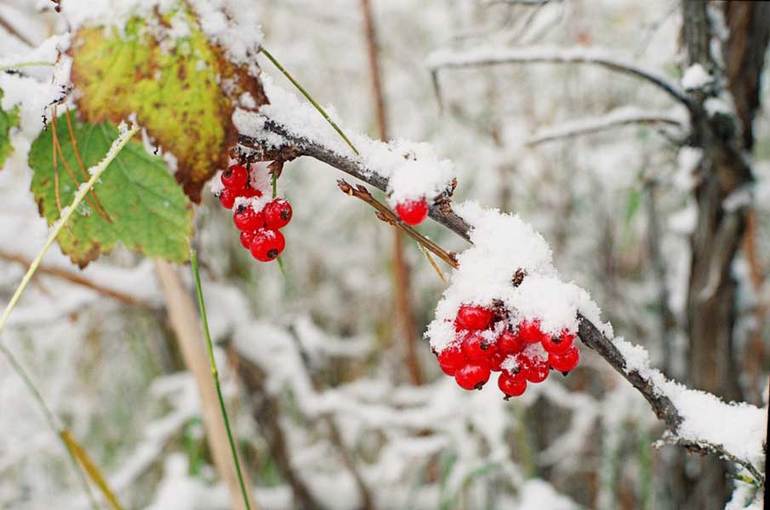

In no case should you fertilize the crop too early., because this can lead to early sap flow, because of which young shoots can die under the influence of cold. In this case, the first frost will entail the inevitable death of the plant.
You can not overfeed the culture and deviate from the optimal rate indicated on the label. An overabundance of nutrients will slow down the development of the bush and reduce the yield.
Subject to all the rules of caring for the crop, the currant will not only freely endure the winter, but also give its owner an excellent harvest. In the spring, it can be fed with growth stimulants and nitrogen-containing fertilizers, which will start the process of active formation of the vegetative mass.
How to feed and whether you need to fertilize in the fall
It is necessary to feed the bush in autumn... Currants draws a large amount of potassium, phosphorus, magnesium from the soil, so a lack of these elements will lead to minimal fruiting next year.
It is recommended to fertilize the soil according to the following scheme:
- Before applying fertilizer, you need to clear the soil around the shrub of leaves. Deciduous foliage can be a breeding ground for various diseases that begin to develop in the spring.
- The soil must be disinfected. For the procedure, potassium permanganate, copper sulfate, a solution of laundry soap are suitable.
- It is recommended to use phosphorus-potassium fertilizers. It is they that provide the basis for laying buds for the future harvest, and stimulate the active growth of the bush.
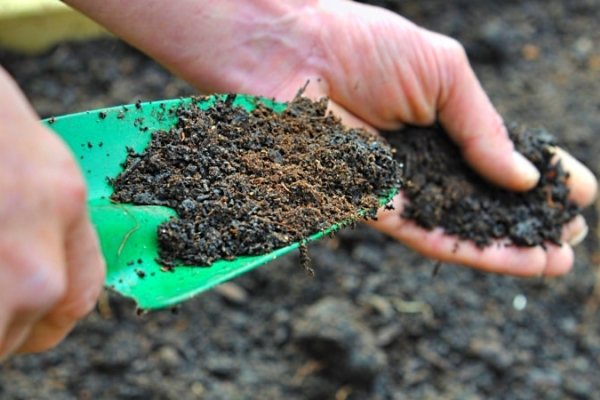

It is necessary to feed the bush in autumn with phosphorus-potassium fertilizers
Black currant - care after harvest, protection against parasites
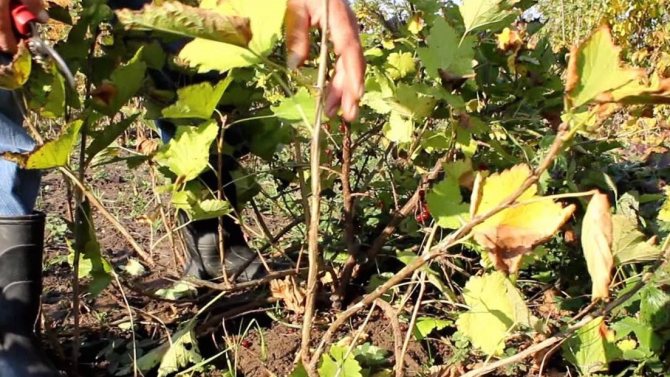

Black currant, perhaps, can rightfully be called the most popular variety of currant. It has a special sweet and sour taste and a very pleasant aroma.
Yes, and a bit of a hassle is black currant - after harvesting it is no more difficult to care for it than for other varieties of this berry. And in a sense, even easier. So, for example, she is much less susceptible to attacks of parasites than her "sister" - red currant.
But even if at first glance the bush looks completely healthy, this does not mean that it does not need treatment. After harvesting, this must be done, because for a long time the bushes have remained defenseless.
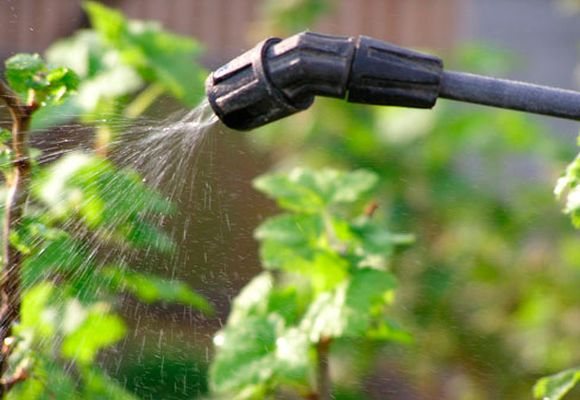

Black currant processing
To protect currants from fungal diseases, you can apply a one percent solution of Bordeaux liquid, Fundazol or Topaz. These drugs will effectively help, for example, in the "battle" with powdery mildew. It is with her that black currants fall ill quite often. If the bush is sick, it is almost impossible to cure it.
The only way is to slow down the development of the disease. Processing is recommended in accordance with the instructions that come with the preparations. If we talk about parasites, then most often black currants are attacked by a kidney mite.
If you saw them in the process of picking berries, you need to do this - five days after treatment with fungicides, treat the currant bush with insecticides. For kidney mites, for example, "Kleschevit" and "Karbofos" are a good remedy.
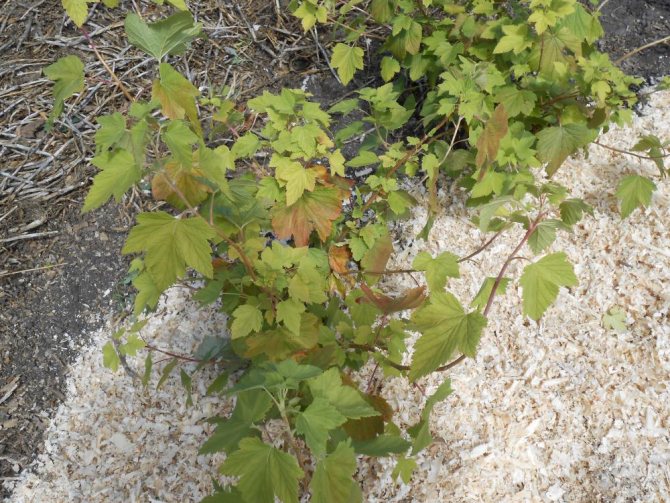

If no insects were found, then fungicide treatment is sufficient. After that, it remains only to sprinkle the near-trunk circle with sawdust or straw. This will help to retain moisture in the soil and protect the root system from overheating.
Video: When and how to plant black currants
Tags:
Share on social networks:
It will be interesting for you to read:
- The best varieties of garden strawberries and strawberries with descriptions and photos: remontant strawberries; how to grow and harvest correctly; beneficial features.
The best varieties of raspberries, description of varieties: red, yellow, black, remontant raspberries. How to plant raspberries correctly
The best varieties of pears for planting in the Moscow region and central Russia with photos and descriptions. How to properly plant a pear orchard. Tips from an experienced gardener
Home flowers that should be in every home. Useful and harmful indoor plants
Pest and disease control: what kind of treatment can be done in spring and autumn?
Pest control is a must, which should be carried out both in early spring and autumn. They mainly use Bordeaux liquid, carbofos and other drugs.
If you find a pest infestation, fight them immediately.
After fruit ripening and harvesting, you can see dried branches and leaves. These are signs of infection with glass.
Infected branches are recommended to be removed immediately so that the pest does not get to the base of the bush. The following drugs are suitable for processing: Lepidocid, Karbofoks, Fitoverm.
Found ticks - immediately treat the bush with special preparations. Neoron, Fitovern, Kinmiks, Kleschevit, Karbofos are suitable.
From gall midges use Neoron, Aliot, Kinmix, Lepidocide.
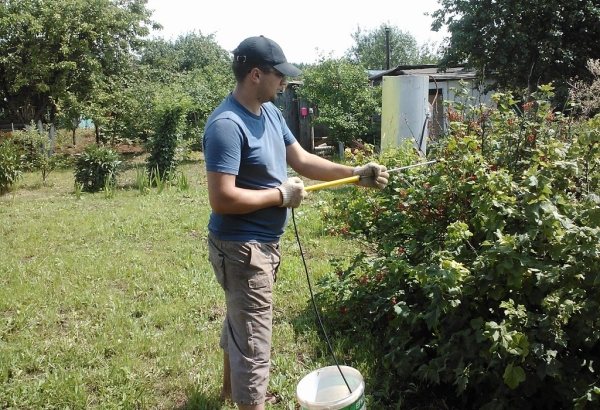

For the prevention of diseases and pests, you can spray currants with 1% Bordeaux mixture
Fertilization methods
The currants are fed during the season in two main ways - root and foliar. They are equivalent, only in the second case, nutrients quickly enter the green parts, and in the first - to the roots, saturating the plant as a whole. Experienced summer residents recommend alternating root and leaf feeding.
Foliar dressing
Nutrients enter the plant literally in a matter of hours, therefore, this method is often used for emergency introduction of nutrients if signs of acute deficiency appear. It is optimal to alternate spraying a weak fertilizer solution with root feeding.
The concentration of the nutrient solution for foliar top dressing is reduced by three times compared to formulations for root application.
Spray the leaves in clear dry weather, in the morning or evening. If the summer is damp, rainy, it is advisable to feed the currants with dry formulations at the root.
Root dressing
The method provides for the introduction of dry and liquid forms of fertilizers. Dry formulations are usually applied to the planting hole or mixed with the top layer of soil in the trunk circle. As the soil is moistened, the particles dissolve and enter the root system. Granules or powders are usually applied in the spring, when the soil is saturated with moisture, their work is most effective during this period. Although liquid fertilizers reach the roots more quickly, it is better to apply them when combined with watering.
If the currants are frozen and start to dry out
The results of wintering shrubs depend on several factors. First, from when the frosts began. Second, how effective the training was. Currants can freeze and dry out. If, nevertheless, the plant has suffered from severe climatic changes, then there is no need to panic, since in most cases it can be saved.
Signs
The following signs will help indicate a plant damaged by frost:
- frozen shoots are painted and acquire dark shades;
- the frozen bark dies off, its color changes to dark brown or brown;
- frost cracks appear on thick branches (longitudinal cracks);
- frozen roots turn dark.
Can currants dry out or freeze - how to save a shrub in winter
The effectiveness of resuscitation procedures depends on the degree of freezing of the currant. To do this, you need to cut off a 3-year-old branch and put it in water (in a warm room) for 4 days.
If the plant is not severely damaged by frost, then after 4 days the cut on the branch will turn light green, and the buds will begin to swell on it. In case of severe damage, the dark shoot will not change color, buds will not form on it.
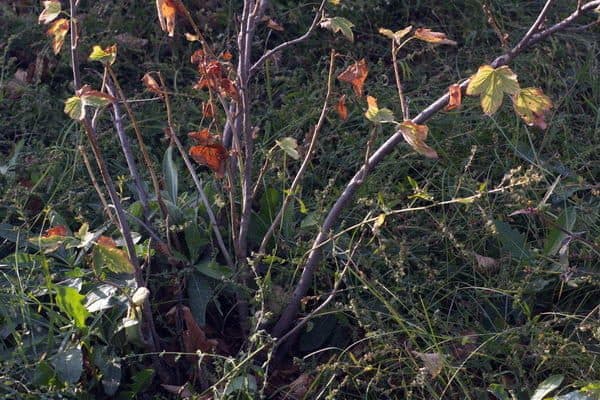

You can determine the degree of trauma in the spring or early summer.
Resuscitation measures if the plant begins to dry out:
- cut off frost-damaged shoots;
- process the cuts with "Garden Var";
- pour abundantly with plain water (without adding mineral or nutritional compounds);
- lay out a layer of humus near the trunk circle.
In the future, the injured currant requires careful care - frequent weeding and loosening of the soil, timely watering and the introduction of nutritious dressings. Find out how to treat brown spots on currant leaves at this link.
Proper watering of currants
In order for the berries to form strong buds, they need moisture. Watering is carried out after pruning and harvesting the leaves. Pour warm fresh water under the bushes in volume: for red currants 1-2 buckets under each bush, under black - 3-4 buckets also under each bush. The next watering will be only in the fall before the wintering of the bushes.
Abundant watering for black currants is needed to nourish the root system, which is located close to the soil surface. Red and white berries have a deeper root system.
How to trim properly
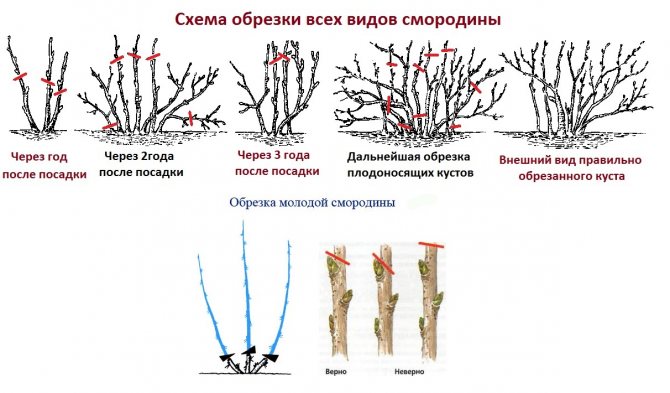

What shoots are cut:
- old;
- deformed;
- sick;
- dry;
- young, too thick plantings;
- not giving berries.
The branches lying on the ground, protruding beyond the boundaries of the crown, are removed. Pre-planting is inspected, noting for themselves weak, damaged branches growing low above the soil surface and shoots in the middle of the bush. They are harvested first, leaving 6 to 10 strong and healthy shoots on the bushes.
For the procedure, use a garden pruner, a saw. Usually, remote branches are removed from the site and burned. Pruning rules:
- cut off the branches above the buds by 1-1.5 cm;
- no hemp is left on the bushes;
- do not break off currants with their hands, only with tools.
First of all, dry and deformed branches are removed, then they move on to green specimens that have not had time to ripen. Slices are covered with pitch.
On a note!
To disinfect the instrument used, a solution of potassium permanganate or medical alcohol is used. Wiping a pruner or a saw after pruning each bush, protect the planting from the transfer of pathogens.
If there are a large number of dry, black-cored branches on the bushes, they are uprooted and burned. After disinfection of the soil, it will be possible to plant new seedlings in the spring.
Rejuvenation of the old bush scheme
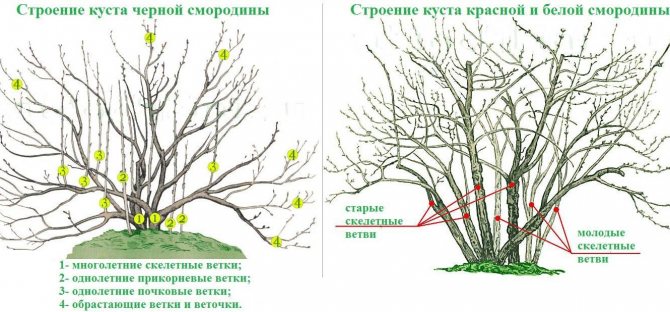

The rejuvenation of currant plantings begins in five to six years. Five-year-old shoots have passed the peak yield, they are cut off. Up to 50% of the bush is removed by cutting off deformed, diseased, old, thickening branches. For the first time, the plantings are rejuvenated in the fifth year, feeding after the procedure with potassium-phosphorus fertilizer for the fastest recovery.
A year later, next fall, they examine the bushes. They choose mature, strong shoots (18-20 pieces), all the rest are removed. After another year, about half of the old shoots and 10-12 pieces of new ones are left on the bush. As a result, in 3-4 years they manage to rejuvenate the old plantings of currants, dispensing with replanting new seedlings.
Formation of a young bush
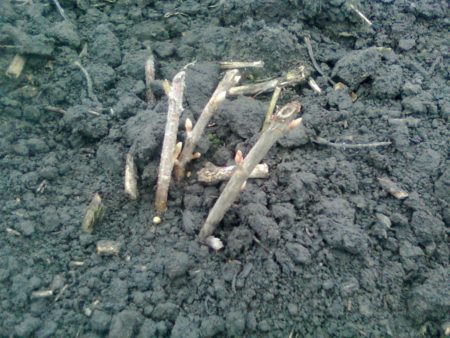

To obtain the earliest maximum yields of berries, it is required to correctly form young plantings of currants.
- To begin with, only the planted berry bush is cut off, leaving 3 buds on the branches. The number of shoots is no more than four.
- When planting two-year-old seedlings, the bushes are cut in July. Each branch of the bush is cut by about 8-10 cm.
- In the first year after planting, the strongest shoots are chosen in the fall, all the rest are removed. This is how they form the skeletal basis of the future bush.
- Cut off the side branches that are knocked out of the crown, which will shade the flowers and berries.
- Usually up to 14-20 branches growing from the soil are left on the bush. A large amount heavily loads the bush, the culture does not have enough nutrition. The berries on such bushes are small, the harvest is small.
Preventive treatment of black currant
When the bushes are cut and sprinkled with the compulsory compaction of the bedding, you need to wait a little until the foliage (more than 80% of all leaves) completely fall off, or collect it from the branches with your hands and burn it outside the territory of the site.It is advisable to carry out preventive treatment of black currant bushes from various fungal diseases, for this you can use two or three percent Bordeaux liquid.
The bushes need to be completely treated with liquid, that is, each branch and it's okay if the liquid gets on the soil, so you will get rid of the wintering stages of fungal diseases, if not completely, then with the highest degree of probability.
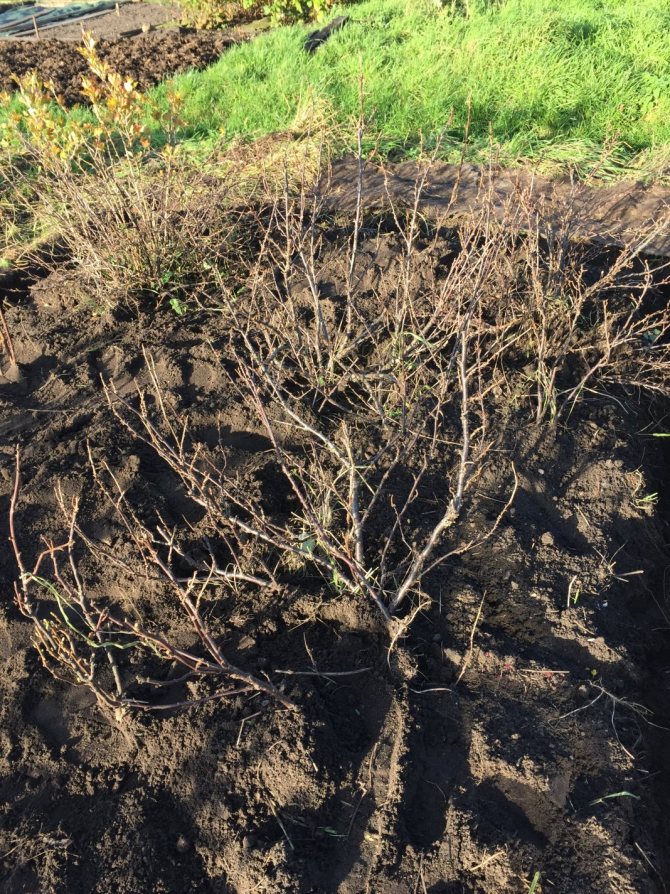

Blackcurrant bushes after autumn preparation. <>
Helpful hints and tips
Novice gardeners often make mistakes when caring for currants in the fall. The most common ones include:
- The introduction of fresh manure under the bushes before the onset of persistent cold weather. Plants receive an excess of nitrogen, which has a negative impact on the preparation for the winter period.
- The use of synthetic materials for sheltering currants for the winter. Wrapping the bushes with polyethylene or other airtight materials leads to the death of the plant. For insulation, only mineral wool, agrofibre, needles, fallen leaves and spruce branches are used.
- Introducing a large amount of organic matter under the bushes. In this case, the shrubs will fatten, actively increase the green mass and will not lay flower buds. Overfed currants cannot stop growing in time and prepare for the winter cold.
- The bush is molded by breaking off branches, or for this, improvised means (knife, nippers) are used. Currants with damaged or torn branches do not tolerate winter well. In addition, wounds inflicted in the fall increase the risk of disease or pest damage. For pruning shrubs, an exclusively designed tool is used:
- secateurs - cut branches, the thickness of which does not exceed 1.5 cm;
- lopper - cut branches with a thickness of 1.5 to 3 cm;
- garden saw - used to work with old currant bushes.
If you provide the currants with proper care in the fall, then in the next season it will certainly delight you with an abundant harvest of large and tasty fruits rich in vitamins and useful microelements.
Adding soil
After fertilizing, once again carefully inspect the blackcurrant bushes: maybe with water-charging irrigation or rains, in some places the roots were washed out on the plants, then they must be sprinkled with fresh and nutritious soil and compacted with a shovel so that no voids, even the most insignificant ones, remain ... It is quite permissible to mix the soil in equal proportions with wood ash, as well as wood or stove soot.
If you do not want to apply mineral fertilizers, then you can use organic matter. So, under each bush of black currant, they often bring in half a bucket of well-rotted manure, but there is no need to rush with this. It is better to add overripe manure at the end of October, it will also serve as a layer of mulch (in colder regions), that is, it will protect the roots from possible freezing if a severe frost falls on the bare ground.
Renewal and loosening of the trunk circle
Renewing the trunk circle is a garden manipulation that involves renewing the old layer of mulch and cleaning the area from fallen leaves. It is necessary in order to protect the site from various wintering pests.
All collected mulch and fallen leaves must be put in compost or burned if the plant is sick with something.
After cleaning the site, you should carefully and shallowly loosen the soil with a hoe or forks at some distance from the bush so as not to hurt its sensitive root system. Loosening will protect the ground from freezing with the onset of winter frosts.
After cultivating the land, it is necessary to form a new hole to facilitate watering and fertilizing. After that, the site must be mulched again.
Mulching and shelter for the winter
After the autumn processing of currants is finished, think about how to protect the roots from freezing.
This will help, of course, currant mulching. Carry out this procedure before the onset of cold weather, but keep in mind, the ground should be still warm.
Remember! Mulching on frozen soil will not help, but only harm, keeping not heat, but cold. With the onset of spring, the soil under such a bush will thaw longer, which will lead to a lag in the development of the plant.
Dig under the bushes before mulching if you haven't already. To retain moisture longer, do not break the earth clods.
Dry fallen leaves, rotted sawdust, small twigs, chopped cardboard, hay, mown grass, etc. can serve as mulch for currants.
Try to take care of the mulch material in advance. For example, if you lay wet fallen leaves around the currants, nothing good will come of it, since it can provoke the onset of a fungal disease.
Do not mulch with branches cut from diseased shrubs, rather burn them.
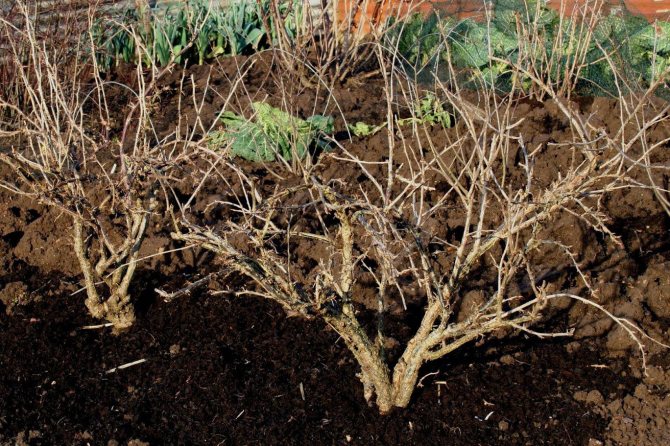

Make a layer of mulch at least 8-10 cm.
This layer helps to maintain an optimal microclimate for the root system of currants in winter, prevents the soil from freezing around the bush.
In central Russia and in more northern regions, mulching alone before the onset of winter is not enough - currant bushes, especially young ones, must be covered.
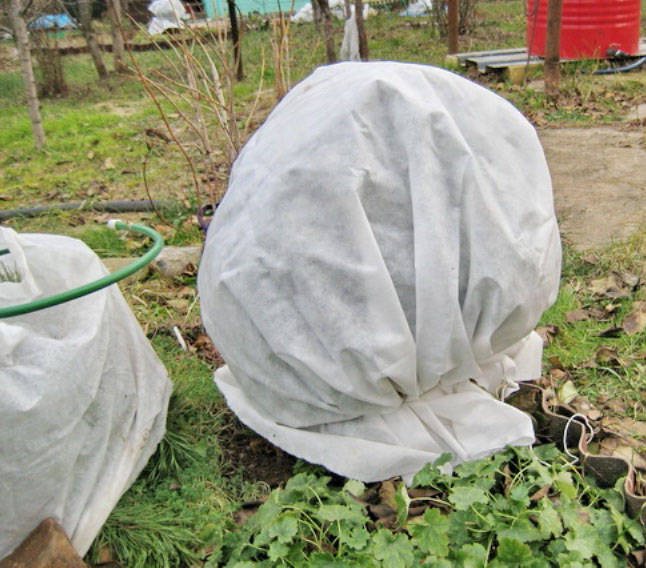

For shelter, they usually use:
- bags with mandatory holes for ventilation, otherwise the accumulation of moisture will lead to the death of the bush;
- coniferous branches;
- non-woven covering material.
In a similar way, currants are covered where there is usually little snow in winter.
In areas with snowy winters, the best hiding place for bushes is snow.
At first, you can rake it under a bush, and as the snow mass increases, completely fill the bushes from top to bottom.
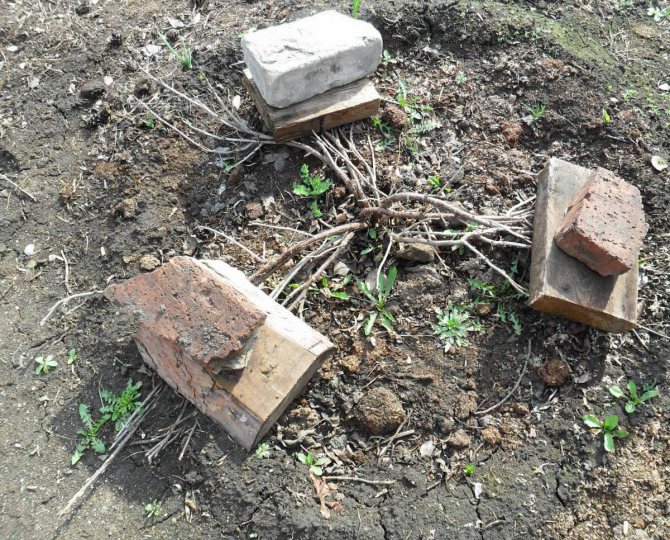

If you think that this winter there will be not enough snow to fall asleep to the top, bend the currant branches to the surface of the earth, pressing them first with a wooden block, and put a load on top of it (this can be an ordinary brick).
If a not too frosty winter is expected or the bush is large enough, then it is enough to pull it together with twine to compact it.
Then he will not be afraid of any winds and sleet.
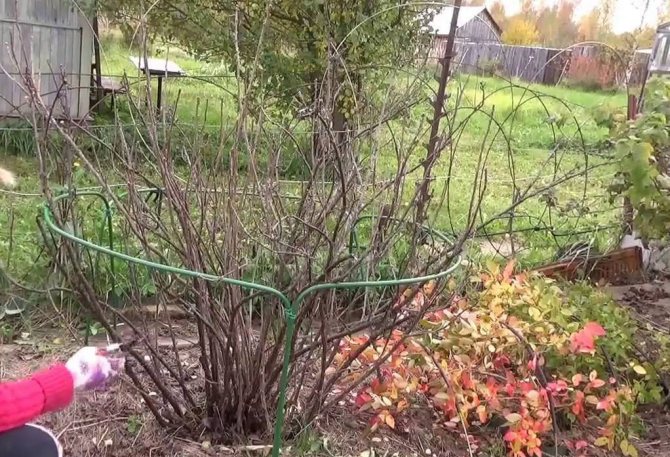

When to cut currants after harvest
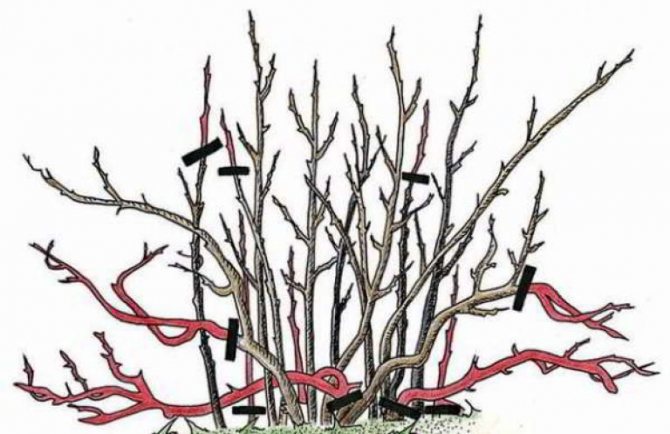

Scheme for pruning currants in the fall
The procedure itself must be carried out in two stages:
The original, the so-called "curative»Pruning, during which it is necessary to remove all obsolete, diseased or damaged shoots. And the twigs that shade the bush.
The next one can be called “cosmetic", Since the bush is given its final shape and the number of branches of different ages is controlled. This will allow the bush to give a healthy full harvest in the future.
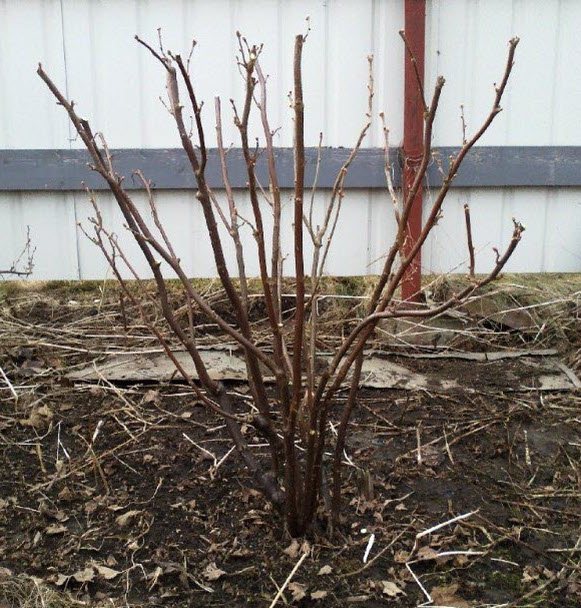

Currants after autumn pruning
An important point: bushes of any kind of currant, the age of which does not exceed three years, only need medical pruning.
As you know, the main part of fruiting is the shoots. The berries are distributed along the entire length of the twigs, which are one or two years old. The branches die after a few years of fruiting. Therefore, it makes no sense to protect shoots that are more than three years old.
For this very reason, experienced gardeners are not advised to grow currant bushes in the form of a boundary line. The bush must have at least fifteen healthy twigs, among which there must be two-year-old, one-year-old and very young ones. Those who are not yet a year old.
What exactly needs to be trimmed:
Branches that are damaged by diseases or parasites; Annual twigs, which in themselves are an obstacle to the full development of stronger branches; Shoots older than three years, which do not grow at least twenty centimeters per season; Aged branches - this will help give life to new young shoots.
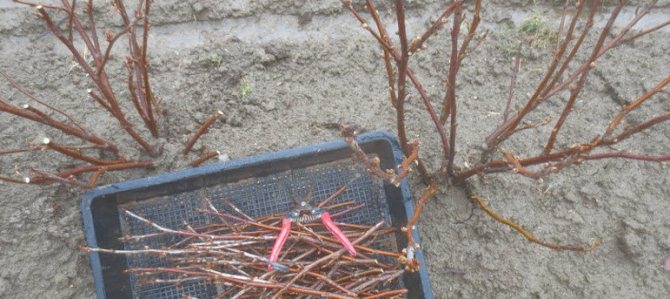

All branches that have been removed must be burned without regret. But when to prune the currants after harvest? Curative pruning can be done almost immediately after picking berries, so that the bushes do not transfer excess force to the wrong branches..
Otherwise, pruning is carried out in early spring or late autumn. It is imperative to carry out this procedure annually.And it is advisable to process all the cuts with garden pitch. And after that, carry out active feeding of the bushes.
Folk remedies for processing currant bushes
When using various herbal decoctions in the autumn, you can achieve only a deterrent effect, and it is unlikely that it will be possible to destroy the larvae of the pest hidden under the dense outer surface of the currant branches. Such treatments should be carried out before leaf fall, when the insects are still active.
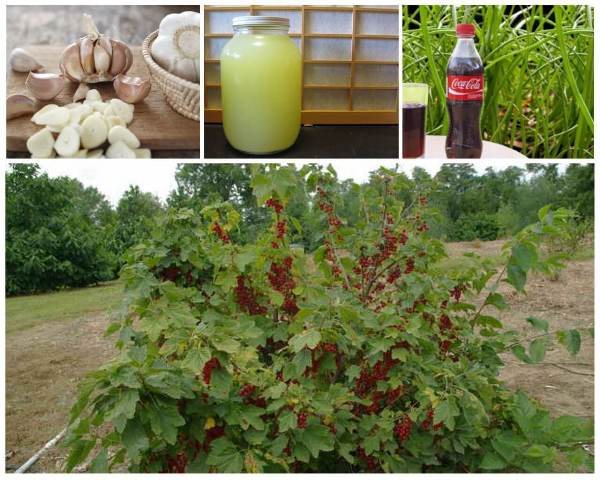

Use water infusions based on tobacco dust, garlic cloves, onion peels. These herbal remedies can be used individually or as mixed teas. To 10 liters of boiling water add 200-250 g of the selected substance or mixture. Insist 4 days. Strain and spray the currants, trying to get to the lower part of the leaves. The same solutions are used for watering the soil in the root area of the currant.
How to make do-it-yourself drip irrigation from plastic bottles
Currant fertilization scheme
Top dressing throughout the entire growing season is carried out five times. The composition of the spring fertilizer is different from that of the autumn mixtures. This is necessary in order to replenish the nutrients that have passed from the soil into the fruits.
Approximate fertilization work plan:
- spring - 2 times: during the period of bud swelling and after the end of flowering;
- summer - 1 time, when berries begin to form;
- autumn - 2 times: after harvest and before frost.
Complex mixtures containing nitrogen are needed in the first two feeding. Nitrogen stimulates the growth of greenery and serves as additional protection against fungus and pests. The amount of greenery and the growth of shoots directly depends on the availability of nitrogen nutrients in the soil. This principle and scheme is suitable for all varieties of currants, as well as gooseberries and raspberries.
Summer nitrogen fertilization is needed if the shrub grows on sandy soil. First, nitrogen substances are not retained in the soil and go to the lower layers. Secondly, the sand cannot hold them, as it is a good drainage.
The currant root system is located in the surface layer no deeper than 40-50 cm, therefore it cannot get food from deeper horizons. In the summer, foliar feeding of currants is carried out.
Usually urea is chosen because it is well absorbed by the leaves. It is used when the leaf plates turn yellow noticeably during the formation of berries in a more diluted concentration. After 2 days, the color is restored.
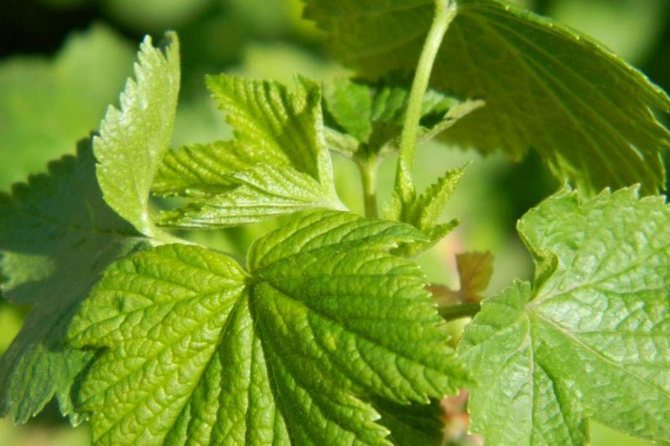

Autumn mixtures are considered to be dominated by potassium, phosphorus and trace elements. Potassium in large quantities is consumed by shrubs during the period of formation and ripening of berries.
For the metabolism to be more efficient, the plant needs phosphorus for the root system. Trace elements are needed in small quantities, but they also affect the immunity and quality of the crop, as well as the condition of the bush itself.
Autumn pruning of black currant
In autumn, pruning black currants can be done quite calmly, but if your soul hurts a lot for the cuts left, then cover them with garden varnish or garden paint, there will definitely be no harm from this. Pruning can start in September and be sure to finish before the first severe frost.
First of all, carefully examine the currant bush, remove all broken shoots that remained after inaccurate harvesting, cut out those that are devoid of foliage into a ring. Perhaps this is a sign of a disease, remove the shoots that literally lie on the ground or touch its surface (remember what dirty berry you collected from them, you didn't even want to put it in a common container with a clean berry).
Next, move on to the blackcurrant shoots, which are dark, almost black in color. These are old shoots, they need to be cut out at the base along with young branches on them, leaving no more than two or three of this age on the plant.
By the way, when cutting off shoots, inspect the core on the cut, it should be clean, light green, but if it is gray-black, then this is a sign that a glass pest has wound up in the plant. Perhaps it struck most of the shoots, and then, no matter how sorry, but the plant will either have to be cut short, leaving only shoots with a clean core, or, if you do not find clean ones, then the black currant bush should be completely uprooted.
Don't forget to remove excess root growth. Many people know that it serves to renew the black currant bush, but there should not be too much of it (no more than three or four powerful young shoots per season). Also check to see if the root growth's core is clean.
Be sure to remove all shoots directed deep into the crown of the bush, their growth provokes a thickening of the black currant bush, leads to a decrease in its illumination, wind blowing, increases the risk of fungal infection and "transfers" the crop to the periphery of the crown.
When pruning, be sure to use sharp garden tools - this is a garden saw and a garden pruner, a garden knife was previously used, but it is not safe, and if you handle it carelessly, you can get seriously injured. For this reason, this instrument has a place on the shelf of a museum, and not in your hands.
Advice: Take a small bottle of alcohol and a napkin with you, and when trimming bushes (more precisely, when moving from one bush to another), treat the surface of the cutting tools with a napkin moistened with alcohol, thus disinfecting them. By following this simple advice, you will prevent the spread of the terry virus. You can, of course, use a solution of potassium permanganate, but believe me - alcohol will cope with this more reliably.
All blackcurrant shoots that you cut down, no matter if they are healthy or sick, are best burned, and the ashes are used as fertilizer (wood ash), this is a good source of potassium and trace elements.
If you do not carry out the autumn pruning of black currants, then you can allow the wintering of various pests and diseases on the shoots, which are activated with the first rays of the sun in the spring.
Mulching the bite zone of black currant
That's practically all. It remains for us to mulch the soil of the bite zone of our black currant plants. Mulch will retain the moisture that we used for water-charging irrigation and will save the root system from possible frost when the soil is not yet covered with snow (in addition to adding soil mixed with wood ash).
As we said, you can use everything at hand for mulching: healthy dry leaves, sawdust, small twigs, shavings, even pieces of cardboard or covering material. The main thing is that in the spring all this must be removed as quickly as possible so that the soil warms up faster.
Fertilization rules
Mineral fertilizers are preliminarily dissolved in water, then a deepening is made in the soil, where the solution is poured, which is added to the ground.
Organic fertilizers are applied both dry and as a solution. Siderata are used in various ways:
- Sow plants around. After two months, they mow and dig up the soil.
- The cut grass is buried in another place, leaving only the root part for the currants.
- Do not mow the grass. In winter, it rots and gives fertilizer.
- Siderata are used as mulch, covering it with leaves, straw or sawdust on top.
There are also folk recipes with which currants are fed. Popular include:
- Potato peelings. They are soaked in water, and then laid out in a pre-prepared furrow near the bushes.
- Bread mash. One bucket will need a third of the leftover bread. Fill a bucket with water and add 50 grams of old jam or simple sugar. As soon as the mass has fermented, it can be used as a top dressing, introduced into a prepared furrow in advance.
- Yeast.For 10 liters of water, 0.5 kg of baker's or brewer's yeast is needed. To get the mash, 50 grams of sugar is added to the yeast diluted in a bucket. One bush will need 10 liters.
Processing currants from diseases and pests in the fall
In the fall, it is important to carry out protective measures for currants against diseases and pests. One of the best prophylaxis is spraying currants with Bordeaux liquid. It is necessary to spray the entire shrub, as well as the ground around it and between the rows.
Additionally, she is also treated with cuts and cuts on the bush. From defeat by the fungus, they are treated 2 times every 7 days.
Processing currants from diseases and pests in the fall
Another effective remedy for diseases and pests of currants is a carbamide solution. You will need 300 grams of substance per 10 liters of water. The entire surface of the bush is sprayed.
There are gardeners who give recommendations not to wait for the leaves to fall off naturally, but to remove them yourself as soon as they begin to fade and turn yellow. This will help the plant to save energy and direct them to rebuilding for wintering. The nutrients will begin to flow to the branches and buds.
Carry out a thorough cleaning of the near-stem area, remove the foliage. For prevention, it is worth treating currants with either a solution of copper sulfate in the amount of 50 grams per 10 liters of water or Bordeaux liquid, in the amount of 100 grams per 10 liters.
Shallow loosening is carried out near the trunk, only 5 cm. Moving further from the center, you can loosen more deeply - up to 15 cm. Loosening up to 30 cm is carried out between the rows. After the procedure, it is recommended to process the soil with Karbofos.
Spices in the garden!
Blueberry BonusBlueberry PatriotBlueberry Bluecrop
You should know a few basic rules that will help prevent the appearance of diseases in currants, as well as damage to them by pests:
- It is worth choosing carefully the varieties of currants, choosing the most persistent, with good immunity.
- Upon detection of the very first, initial signs of a disease or detection of insects, it is worth immediately applying insecticides or fungicides.
- The best time for processing is dry and calm weather. It is not recommended to carry out the treatment immediately after rain or after dew has fallen. Wait until the humidity drops.
The most common diseases and pests of currants
As with every crop, currants tend to be susceptible to certain diseases and attack by some pests more often than others.
Among the disease, anthracnose, powdery mildew, and rust are distinguished.
Anthracnose is represented by red specks on the leaves.
Increasing in size over time, they occupy the entire surface of the leaf. As a result, foliage dries up and falls off. Be sure to collect damaged leaves before wintering and burn them.
Photo of the disease of currant Anthracnose
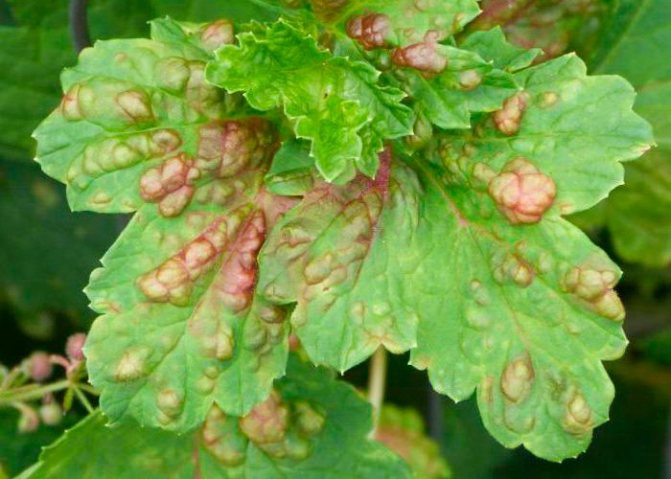

Powdery mildew in currants is represented by a bloom of white.
It appears on leaves and berries in the very middle of July. It can appear only on weakened plants.
Photo of a disease of currant Powdery mildew
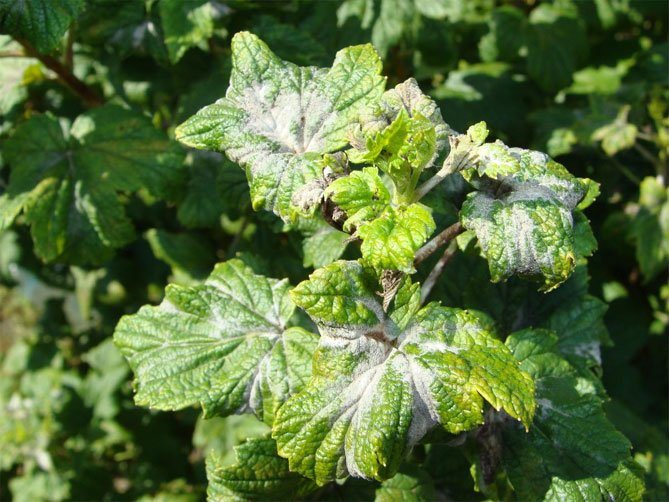

Rust is represented on currants by orange growths,
slightly convex.
Photo of currant disease Rust
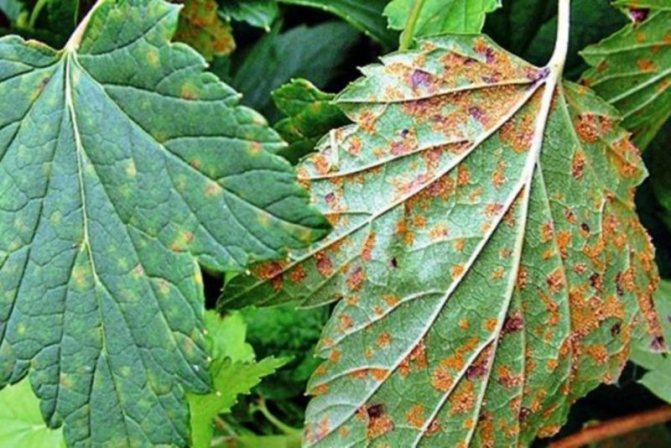

Among the most common pests:
butterfly - glass, aphid, moth.
Processing currants from powdery mildew in autumn
It is possible to fight powdery mildew in currants with both natural preparations and chemical preparations. From the means of organic origin, it is worth highlighting biological fungicides.
Processing currants from powdery mildew is carried out in three stages:
- before flowering;
- after flowering;
- after harvest.
Diseases of the Currant - video
Processing currants from powdery mildew in the fall carried out immediately after harvest and should be repeated after 10-15 days.
You can use the drugs described below.
On a note!
It is very important to read the instructions for using the products before processing the currants.
Trichodermin for currants
The action is aimed at suppressing the growth of mycelium and at the same time enriching the soil with useful substances. To prepare the solution, take 10 liters of water and 200 grams of powder. Dissolve thoroughly. Currant seedlings for planting are treated with Trichodermin, foliage is sprayed.
SWEET CHERRY!
Cherry FatezhCherry OvstuzhenkaCherry Leningradskaya black
Fitosporin-M for processing currants
The composition of the product is based on bacteria that stop the development of powdery mildew. For processing, take 5 grams of funds per 10 liters of water. Spray currants with Fitosporin-M 2 times:
when leaves open and when ovaries form.
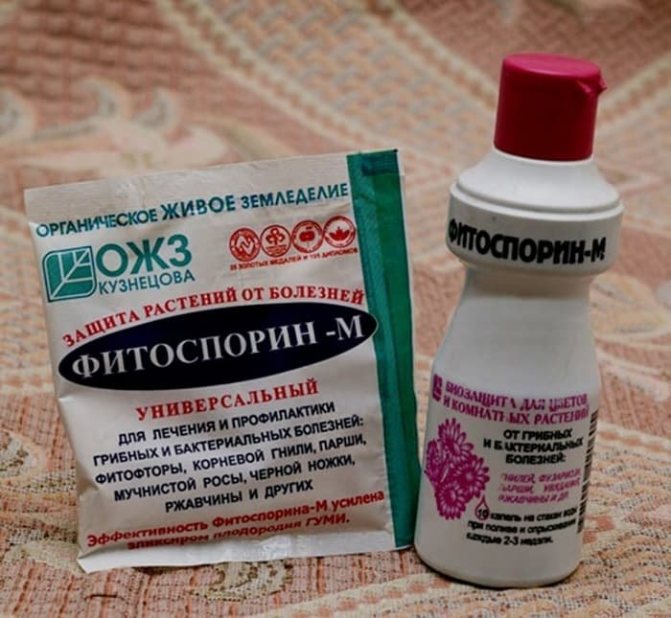

Chemicals are stronger and have the fastest effect. At the same time, they are more toxic than biofungicides. They work where the latter are powerless.
Copper or iron vitriol - currant processing
For 10 liters of water, take 100 grams of copper and 300 grams of ferrous sulfate. Stir until the crystals are completely dissolved. Before using the solution, you must additionally pass it through the filter, so that for sure there are no grains left. Applied during the period of budding. The shoots and soil around the stems are moistened.
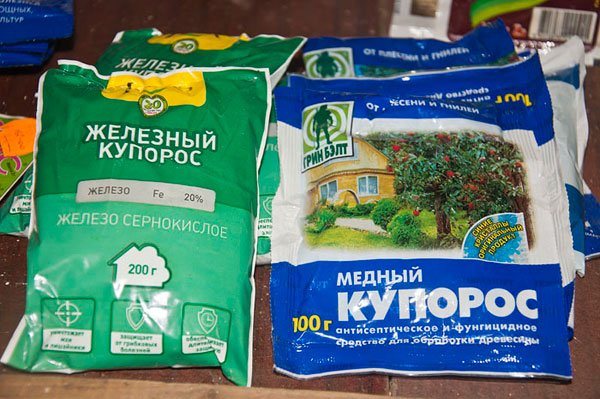

Topaz
Quickly blocks the multiplication of fungal spores. To prepare the solution, you will need 2 ml of the product for 10 liters of water.
With such a Topaz solution, both preventive treatments of currants can be carried out, and with a therapeutic purpose.
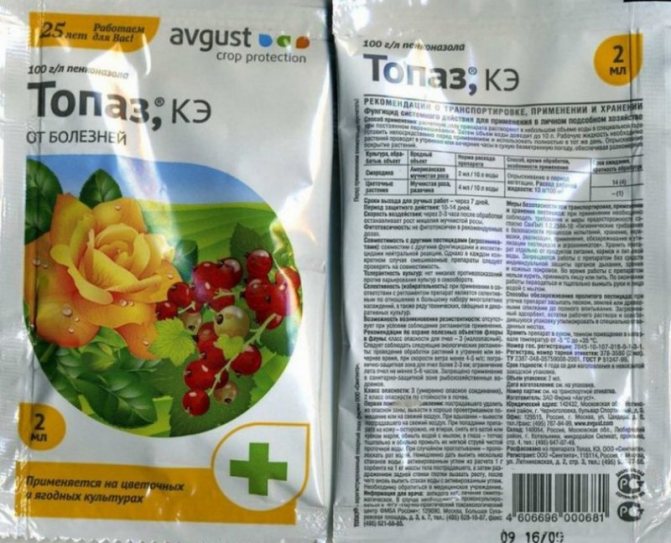

Fundazol
Fungicide, which has a curative and protective effect. Prepare a solution of Fundazole for currants in the amount of 10 grams per 10 liters of water and spray.
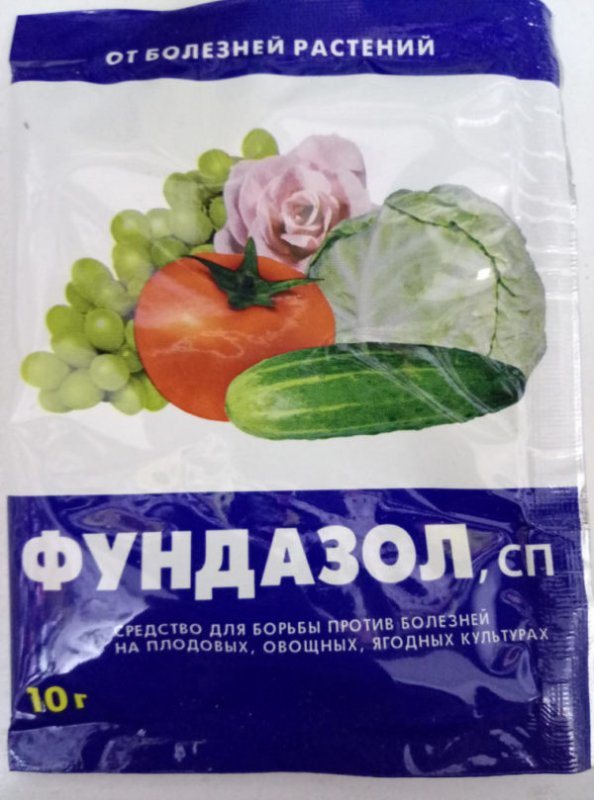

"Folk" remedies for powdery mildew for processing currants
Some gardeners prefer "folk" remedies. As a rule, all substances are always at hand. For example, soda, laundry soap.
Soap solution with wood ash
From 2 to 3 kg of ash are poured into a bucket, water is poured, put on the stove, bringing to a boil for half an hour. Laundry soap is crushed in the form of shavings and added to the total mass. After cooling, the affected shrubs are treated.
Photo of preparation of a solution with wood ash
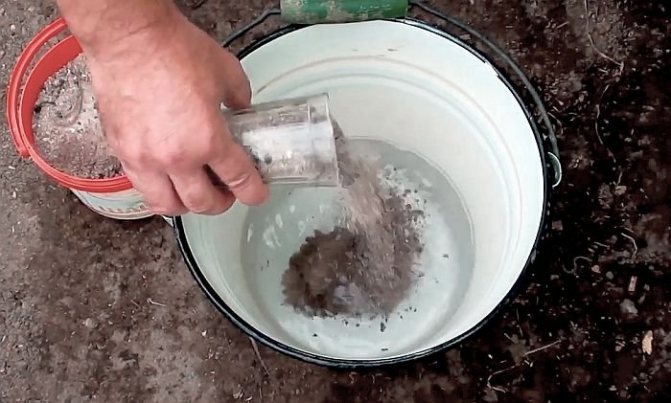

Milk serum
To use this tool you need to look at the forecast for the next 14 days to be sure there is no rain.
The product is effective only in dry weather.
The serum is diluted in half with water, after which it is processed twice every 7 days.
After this treatment, a thin film is formed on the foliage and fruits. It blocks further spread of the fungus.
Photo of preparation of milk whey
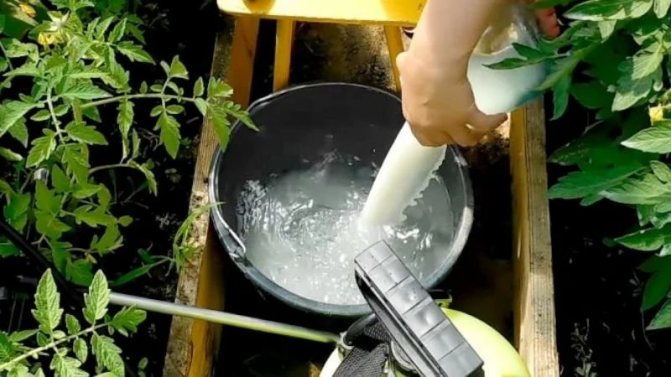

Soda
Prepare a solution of 10 liters of water and 2 tbsp. l. soda.
For better fixing on the treated surface, add shavings of laundry soap in the amount of 1 tbsp. l. Such a solution can be used already when the first signs of powdery mildew appear.
Photo of the preparation of a solution of soda
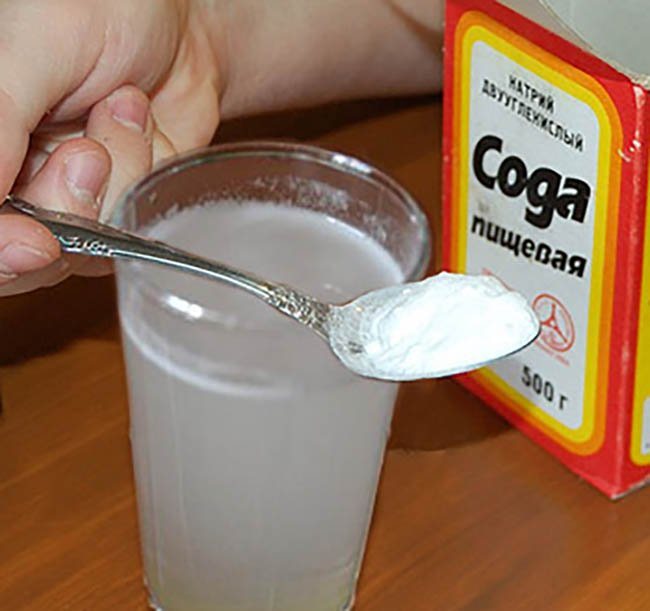

How to deal with currant kidney mites
Kidney mite is one of the possible pests of black currant. Belongs to four-legged ticks. It has such microscopic dimensions that it is difficult to see it with the naked eye. Body color is white. The shape is oblong. It feeds on plant sap.
Photo of a kidney currant mite
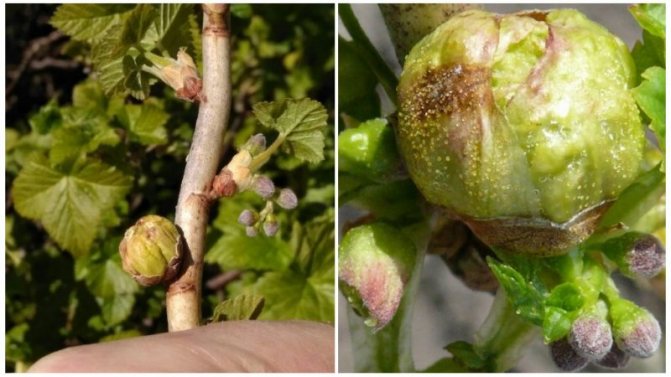

To eliminate kidney mites resort to acaricides with low toxicity.
The most favorable time for processing currants from a tick is the appearance of new buds. Typically, this period is 15 to 20 days.
They are processed from 2 to 3 times, taking breaks of 10 days.
The first drug recommended for use is colloidal sulfur. Spraying the ground around the bush and the bush itself.
There is a significant drawback:oxidative process, resulting in the release of harmful sulfuric gas.It starts at a temperature of + 20 degrees.
Among the means that act non-systematically, the following can be distinguished:
- Actellik;
- Oberon;
- Apollo;
- Neoron;
- Movento;
- Nissoran;
- Kinmix.
Biological products:
- Aktofit;
- Fitoverm.
RASPBERRY CUTTING!
How to prune raspberries in spring, autumn, summer
Systemic means:
- Pilarmax;
- Accent;
- Famidophos;
- Rogor-S
- Phosphamide.
It is necessary to carry out preventive measures,
to prevent the appearance of a kidney mite. First of all, when choosing and planting cuttings, it is necessary to carefully examine for the presence of pest damage, to choose only healthy branches.
Before planting currants in the fall, it is imperative to carry out treatment for ticks in the form of soaking in a solution of potassium permanganate or Fitoverma. You can take tea leaves in the amount of 15 grams per 5 liters of water.
Purposes of top dressing
Currants are unpretentious, even without top dressing, it will yield a crop, but its quality will be poor - the berries will turn out to be small, sour, poor in nutrients, devoid of aroma. Without additional nutrition, the bushes will quickly degenerate, bear fruit irregularly, and get sick more often. On the other hand, timely and well-fed bushes are less susceptible to infections, pest infestations, they yield annually, responding to fertilizers with sweetness, aroma and large size of berries.
Periods
The growing season - from the appearance of buds to the fall of leaves, is divided into certain periods. Their duration is different, since the value of each stage determines the stage of growth and development of the plant.
Before flowering
At this time, the basic processing of bushes is done by default. Regardless of how good the growing conditions are, there is no way to completely protect the garden, since most pathogens are carried by rain, wind, and insects. The best time is considered to be spraying before the leaves appear, since higher concentration preparations are allowed. When leaves appear, the concentration must be reduced, as the risk of burns increases.
During flowering
This refers to the very beginning of this period, when the buds are just emerging, but have not yet blossomed. Most often, insecticides are used at this time, since in time this period coincides with the breeding period of most insect pests. At the same time, processing before blooming flowers ensures color retention and does not repel pollinating insects. And the likelihood of burns or flower poisoning is also noticeably reduced.
After flowering
After flowering, spraying is required for diseases. For currants, the greatest danger is anthracnose, septoria, gray rot, and among insects - sawfly and mites. It is preferable to use a single broad-spectrum drug. Usually Bordeaux liquid is used in this capacity. If there is no infection, then it is better to use folk remedies, since the latter do not pose any danger to the plant.
When the berries are poured
Currants with berries are sprayed with potent chemical fungicides only for treatment. As a rule, at this stage, not only leaves and shoots, but also fruits are infected, so that the harvest is no longer expected. If other cultures are sick, and currants only need protection, then during the ripening period of berries it is allowed to use only biological preparations or folk remedies.
Autumn care
In addition to pruning, black currant bushes need additional nutrition, autumn watering. It is necessary to take care of preventive treatment of plantings from diseases, protection from cold weather.
Long wintering period - stress for plants, without care and preparation for winter, plantings freeze and get sick. All this affects the yield indicators in the future.
Treatment of the bite zone
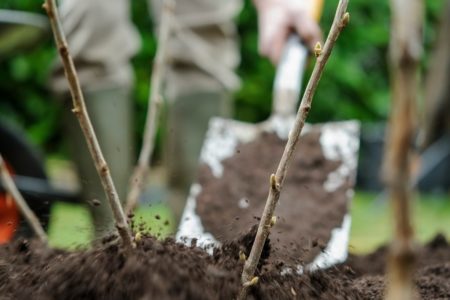

The area around the bushes requires special attention in the fall. There are different points of view of gardeners on the use of agricultural techniques:
- obligatory digging of the soil around the bushes in order to destroy possible pests;
- only mulching the area, without digging up the soil.
All options have supporters, but the results are being tested in practice. Some gardeners loosen the near-trunk zone, and after fertilizing and watering, they mulch the soil. Others are limited to only one digging, others do not touch the soil, sprinkling the ground with mulch closer to frost.
When digging, the forks are buried no more than 8-10 cm so as not to damage the currant root system. For mulching, choose any suitable materials:
- covering fabrics;
- leaves (dry, no rot);
- small twigs;
- shavings;
- dry sawdust.
Mulch the soil after water discharge irrigation. Mulch will retain moisture, protect the currant root system from frost in the absence of snow cover
Watering
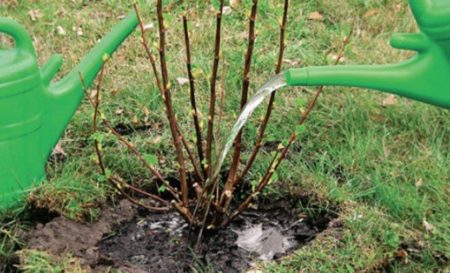

In the fall, in the absence of rain, water-charging watering of plantings is carried out. What does such a procedure give?
- Saturation of the soil with moisture.
- Root system growth.
- Protection of the earth from rapid freezing.
- Reducing the risk of rapid soil thawing during winter thaws.
- Maintaining the stability of the soil structure.
- Creating a moisture reserve for spring.
Watering is not accidentally called charging, since its essence is in the introduction of a large amount of water. Terms - from mid-September, when the bushes begin to shed their leaves.
- planting up to five years, watered 3 buckets under a bush;
- older plantings - 5-6 buckets under a bush.
Water should be absorbed into the soil in the area of the bushes, and not spread out. It is recommended to water from a hose, carry out sprinkling of plants. On sandy soils, irrigation rates are higher, on clay soils, the amount of water is reduced by 2-3 times. Also, the norms are reduced if there are prolonged rains in the fall.
Top dressing
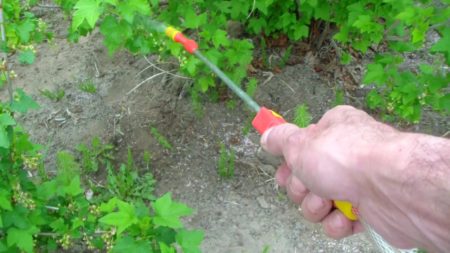

After harvesting, currant bushes need adequate nutrition. The plant gave all its strength to ripening the berries, weakened, and without top dressing it can not endure the winter cold.
Suitable fertilizer mixtures:
- superphosphate and potassium (it is enough to sprinkle 1 tablespoonful spoonful of fertilizer under the bushes, embed it in the ground);
- wood ash (both for nutrition and mulching).
For bushes whose age has "passed" for five years, the fertilizer rates are doubled. Before the very frosts, humus or a well-rotted mullein is allowed under the bushes. When applied in autumn, organic matter will decompose over the winter into easily digestible components, which are useful in spring for currants. In addition, organic matter, like mulch, will protect the ground from freezing, retain moisture in the soil.
Adding soil
Another technique is adding soil for planting currants. After abundant water-charging irrigation and top dressing, the roots are often exposed at the bushes. Such plants run the risk of freezing in cold weather, so they add fresh, clean soil. It is recommended to lightly compact the soil after adding.
Some summer residents mix soil with ash and then pour the mixture under the bushes.
How to spray currants in the fall from pests and diseases


In October, currant plantings are treated for pests and various diseases. If there are lesions, damaged shoots are cut out, the soil around the bushes is dug up and disinfected. During the harvesting of berries, spraying with drugs is prohibited, after the return of the crop, treatment of the bushes begins.
The danger is a kidney mite. Before the cold weather, the insect climbs into the buds of the berry, hibernates there, continuing its dangerous activity in the spring. Bushes damaged by a tick slow down growth, dry out. The buds do not bloom on the shoots, the normal development of the culture is disrupted. A kidney mite spreads various infections that are dangerous for currants, for example, mycoplasma disease.
Various drugs are used to combat:
Bushes are processed immediately after picking berries, while it is warm.The action of bactericidal agents when the air temperature drops will not be as effective.
Closer to October, more effective drugs are used for the tick:
When processing, observe the instructions for use of the product, personal protective measures.
If powdery mildew was noticed on the currant bushes in the summer, then in the fall it is necessary to process the plantings with special preparations. Without spraying, infected plantings of black currant often freeze out in winter and get sick. By spring, the bushes look weak, lifeless, and often die. From ready-made funds are offered:
A good result is obtained by spraying the branches with a solution of tar soap and sulfur:
- rub the shavings of soap (about 2 tablespoons);
- add 40 grams of sulfur to the water, mix;
- add soap shavings to the solution.
The bushes are treated with the composition immediately after harvesting the berries, while there are still leaves. It is advisable to spray the planting 2-3 times. All damaged and diseased shoots are cut and burned. They also carefully rake and destroy all the foliage collected under the currant bushes.
Prevention of black currant infections in autumn
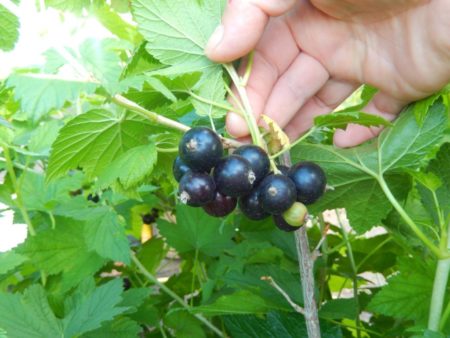

In addition to treating damaged bushes, gardeners do not forget about disease prevention, protecting healthy plantings from possible pest attacks. Events:
- spraying with karbofos, Bordeaux mixture;
- treatment of plantings from a spray bottle with copper oxychloride;
- disinfection of bushes with infusions of onion husks, ash, tobacco.
To disinfect the soil under plantings, use a 1% solution of copper sulfate, a pink solution of potassium permanganate.
Possible reproduction of black currant in the fall
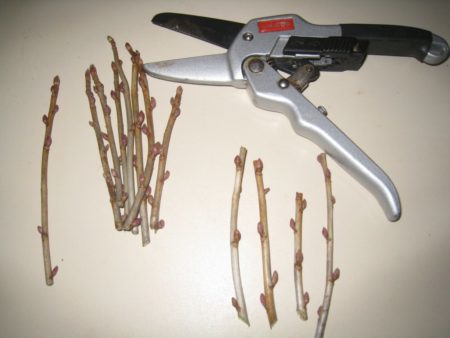

In the fall, gardeners harvest currant cuttings for planting in the spring. This is how the variety you like is propagated, and also saves diseased bushes from complete death.
It so happens that signs of the disease are found on the currants. Pruning did not help, and the plant has to be uprooted. But before that, it is recommended to carefully look at the shoots, since there is a possibility of finding healthy branches for grafting among the one-year-old shoots.
They are cut, cut into cuttings (10-15 cm), planted in a prepared bed. A pair of buds are left above the surface, the processes are planted at a slight slope.
For the winter, a bed with cuttings is torn up with a cloth, burlap, and then snow. In the spring, after the awakening of the cuttings, the strongest and development are selected, the rest are removed. The cuttings that have grown by the fall are transplanted to a permanent place. Planting and leaving are standard, in compliance with the rules of agricultural technology. Planting by cuttings in autumn is suitable for southern regions; in areas of risky farming, it is advisable to plant bushes in spring.
Bending branches
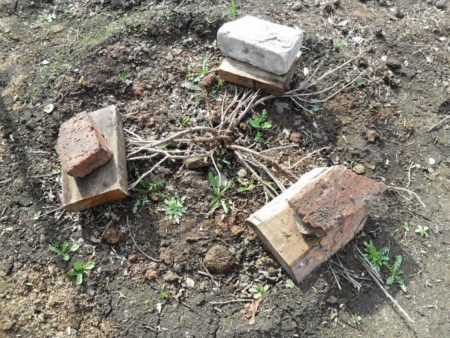

Black currant is unpretentious and frost-resistant, but in cold winters there is a risk of freezing of the branches. It is believed that the plant can withstand frosts down to -27ºC… -30ºC, but at lower temperatures the bushes freeze out.
To avoid this disaster, in regions with severe winters, bush branches are bent to the ground.
- Branches are bent to the ground, pressed with stones or fragments of bricks. Sprinkle with soil on top.
- The branches are wrapped in agrofibre, slightly bent to the ground.
- The currants are wrapped in non-woven materials, adding mineral wool as an insulating layer.
Some summer residents use plastic wrap. But this is not recommended, the shoots do not "breathe", condensation forms, there is a risk of plant death.
In the spring, the currants are opened early, carefully removing the protection and straightening the branches. You cannot be late, otherwise the branches will undermine, the bush will get sick and die.
Digging and mulching
There are always many problems with other crops in the spring, so pruning for gardeners is best done in the fall. After all the leaves have fallen, you can start pruning the shrub. It includes:
- pruning dried and diseased branches;
- pruning old stems.
During this procedure, you must have a sharpened pruner or garden shears with you.It is important to leave fruit-bearing branches and get rid of others. Thin branches do not tolerate frost well, so it is also better to cut them off so as not to overload the root system.
Pruning takes place at ground level. Removing old stems and replacing them with new ones will help increase yields. The tops of the shoots on old stems are shortened, which promotes branching in the spring.
Usually, pruning begins from September until the first frost. Old shoots are cut off at the base. It is important that the core on the cut remains clean, otherwise the pest will start. Then the root shoots are removed.
Removing the crown of the bush will be equally important to thin out the branches and give the plant more sun. This will increase the yield. We must not forget that all shoots, sick or healthy, must be burned in order to prevent the appearance of garden pests.
Gardeners noted a number of serious mistakes that inexperienced summer residents make.
- Using organic fertilizers under the bush. It is better to make them after cold weather.
- The use of synthetic materials as a cover for the bush. He may not have enough air under such cover.
- Branches break off by hand without using a tool. This weakens the bush.
- Organic fertilizers are applied late. This will lead to an abundant growth of unnecessary shoots.
So that there are no questions about how to prepare currants for winter, it is important to know that plant feeding is no less important element than care, pruning and processing.For a shrub about five years old, you need to fertilize in the form of superphosphate (25 g.) And potassium sulfate (15 gr.). An older plant will need more fertilizer.
Many summer residents notice that after the rains, the roots of the plant are washed out and they need to be poured with fresh earth and compacted with a shovel. You can also mix the ground with ash. Anyone who does not want to use mineral fertilizers can always use organic fertilizers, mixing them with mulch.
This information will interest all gardeners who breed currants. It is carried out with lignified cuttings, which can save this garden culture from extinction.
Those gardeners who have found a diseased plant on their site should not rush to throw out the bush. Several healthy shoots can be found on it, with which you can prolong the life of the culture. The main thing here is to cut off healthy shoots 15 centimeters long and transfer them to a loosened garden bed lit and warmed by the sun. Plant the cuttings at an angle of 45 degrees, deepening them so that only a few buds remain.
They need to be closely monitored and wait for their awakening in the spring. The next year, from the awakened cuttings, you can leave the strongest and most well-developed ones, and pull the rest out of the ground. In principle, such care should be given to any variety of currants.
From the article it is clear that caring for currants is not a big deal. The main thing is to find the strength and desire to spend several days of work on the site and do all the work before the onset of frost.
Berries of red, black and white currants are very useful, contain natural pectin (a gelling agent), and are successfully used in canning.
However, in order for the plant not only to survive, but also to please with a bountiful harvest, it is necessary to provide proper care for the currants in the fall. Preparing for winter is not a precaution at all, but a necessity.
Autumn care for currants is carried out not only so that the bushes successfully overwinter, but also to increase the yield in the next season and the convenience of picking berries.
Due to the relatively mild winters (in comparison, for example, with the Republic of Sakha) in the near-capital region, few people in the Moscow region think about how to prepare currants for winter - a hardy shrub will tolerate frosts and so on.
So, the preparation of currant bushes for winter must be performed in the following stages:
- loosen and water the soil;
- take care of protection from parasites;
- cut off excess branches of the bush;
- make top dressing;
- think over the protection of the root system from cold weather.
Providing currants with proper wintering, pruning and other chores will be a big plus for subsequent harvests. Experienced gardeners believe that a properly cared-for currant bush can bear fruit for up to two decades.
First you need to free the surface under the bush from fallen dry leaves and remnants of old mulch. It is better to burn what is collected immediately: this will prevent the spread of fungus and parasites. Next, you should disinfect the soil with a solution of copper sulfate or potassium permanganate.
Planting, growing and caring for grape seedlings in the Moscow region
Most often, for physical processing of the soil under a currant bush, it is enough to loosen it well. However, when loosening, you should be more careful: the root system of the currant is fibrous, contains many processes. In order not to touch the roots, the soil should be treated with a special garden fork no deeper than 8 cm under the bush itself and at a level up to 15 cm outside the crown.
In some cases, the gardener will need to dig up the soil under the plant. This may be required if:
- the soil on the territory of the site is silty in structure;
- the layer of earth is too compacted and became heavy;
- there is a suspicion of the presence of parasitic insects in the soil;
- it is necessary to add organic fertilizing or mineral fertilizers to the soil.
As for fertilizers, it is better to use a very small amount of organic matter (such as manure, humus), minerals with phosphorus and potassium in the composition.
The use of mineral fertilizing containing nitrogen in the autumn should be avoided: young shoots discarded by the plant will make the bush vulnerable to frost.
The mulch layer is created from materials such as sawdust, peat, compost or chopped straw. It will be very good if you put chopped garlic tops in a layer of mulch, it will scare away many parasites from the currants.
The first stage of care must be carried out even before the foliage falls: in order to get rid of bacteria and fungi on the currants, you can abundantly spray the crown with a urea solution. To prepare the solution, take 100 g of urea per 10 liters of water.
The second stage of preparing currant bushes for winter - cutting off excess branches - is carried out after the plant has dropped its leaves. This stage will help the bush to develop fully, make it easier for the sun to access the shoots and help the gardener to get to the berries easier in the next season.
Which electric grass trimmer to choose
Pruning should be done with a serviceable, sharp tool - garden shears, a special knife. For especially thick branches, use a small hacksaw. Be sure to take into account that excessive damage to the branches will take away a lot of energy from the plant to heal it.
Young shoots growing in the center of the bush are also better to be removed, they are unviable due to poor access to light and will only load the root system during the winter cold.
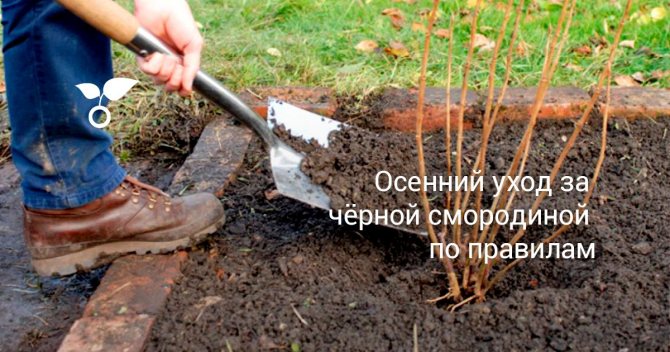

Also, you should not spare the branches without branching (twigs) and radical young shoots that appeared this season, you need to leave only 3-4 of the strongest of them.
This configuration of the plant will help maintain and maintain the yield of currants for many years.
In regions of Russia with a harsh climate, additional measures must be taken to prepare black currants for winter. Despite its resistance to cold weather, extremely low temperatures and strong winds can damage the plant: significantly reduce its yield or even kill it.
Emergency protection measures include bending the shrub to the ground and providing additional shelter for the currants for the winter.
Choosing a snow shovel: which one is better
In no case should metal objects be used to bend the currant: its high thermal conductivity will transfer cold to the plant and contribute to the death of the branches. Also, you should not cover the bush from the cold with synthetic materials or film: under them the plant will suffocate from lack of oxygen.
After bending the bushes to the ground, you can cover the currants - some varieties do not tolerate severe winters. Fresh snow is considered the best and most natural material for shelter - it can be collected and thrown over the bushes from the very first snowfall.
In the case of a frosty, but snowless winter, the plant can be covered with specially stored coniferous paws. You can also purchase a special material that is sold in shops for wrapping shrubs.
When all the stages of preparing currants for winter have passed, you can reward yourself for your efforts by boiling hot tea and uncorking a jar of delicious vitamin currant five minutes.
Possible reproduction of black currant
In conclusion, I would like to talk about the sometimes necessary and important reproduction of black currant by lignified cuttings. This may well be included in the category and topic of care for the simple reason that often a disease or pest, at least the same glass, can affect most of the plant, and uprooting and throwing a favorite variety in the trash can be insulting to tears. And reproduction by lignified cuttings of black currant can save the situation, and in the process of caring for the plant, you will save the life of this particular variety.
Do not rush to throw away the diseased blackcurrant bush, delve into its annual growth, maybe you will find one or two shoots, or maybe a dozen, and then there is every chance that this variety will continue to grow on your site. All that is needed is to cut them (healthy ones) to a length of 15 cm and make a small bed in the garden, well loosening and watering the soil. Next, obliquely, at an angle of 45 degrees, so that the barrel is heated by the sun, plant the cuttings, deepening them so that only a couple of buds remain on the surface. Plant them ... and wait for the buds to awaken in the spring. From a bunch of awakened cuttings of black currant, you can leave everything or choose only the strongest and most well-developed ones, and pull out the rest, thinning the micro-plantation. Thus, caring for currants on the site will turn into a real salvation of a dying variety.
Read our detailed material: Reproduction of currants by autumn cuttings
As we can see, caring for black currants in the autumn period is no different. You will have to spend a couple of days to work on the site, but you can also look at it from the other side: winter is coming and we will not see our favorite site for six months, so enjoy the "extreme" days of warmth and simple, but such extremely useful work!
Why do currants need pruning?
The procedure is necessary, as well as fertilizing and moistening the soil.


Cutting currants in the fall allows you to:
- increase productivity;
- accelerate the growth of new branches, and, consequently, the quality of the fruit;
- provide a sufficient amount of light, which will allow the shrub to grow and develop normally, to bear juicy, sweet, large-sized fruits.
Due to the timely and correct pruning of currant shoots, the flowering time is lengthened, so that the plant can bear fruit for 2 decades.
How to feed currants after harvest
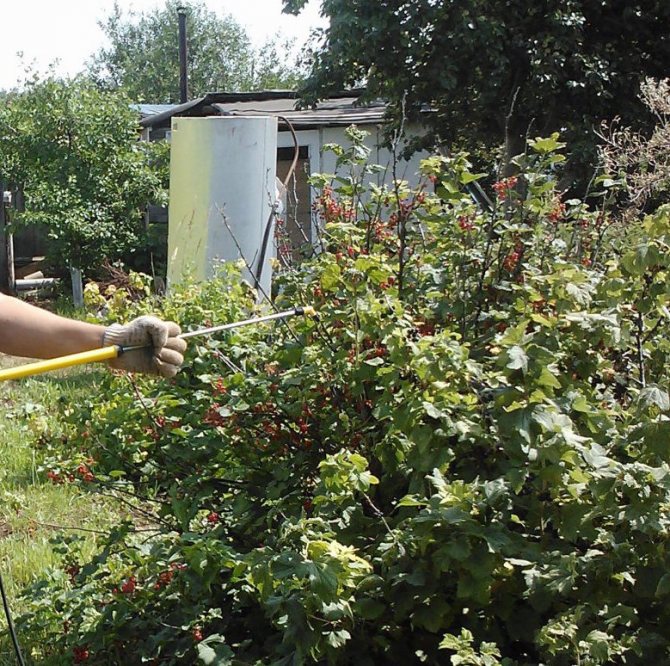

Fertilizing currants after harvest
It is allowed to make both organic and mineral dressings. But we must not forget that in any case potash and phosphorus components must be included there.
How to feed the currants after harvesting? Experienced experts advise using the following fertilizers:
- A mixture of potassium sulfate and superphosphate - one tablespoon for a whole bucket of liquid;
- Mixture of urea, superphosphate - one tablespoon per bucket of liquid, plus a glass of wood ash;
- Mineral fertilizer it is advisable to use if the bush is weakened;
- If we talk about organic fertilizers, it is allowed to use bird droppings and verbascum (he's a mullein).
Litter must be diluted in water in a ratio of 1 to 12 and insisted for two weeks. Take half a liter of tincture for a whole bucket of regular liquid. Mullein should be diluted in equal portions and infused for a week. The liquid will need to be poured into the furrows made in the process of loosening the earth.
Remember that any kind of currant simply does not tolerate bleach. This is especially true for red currant varieties. Therefore, using potassium chloride for fertilization is a very bad idea.
If you don't have enough time to make organic infusions, compost is a good alternative. It must be brought in at the rate of one bucket per one bush.
Do not forget about the benefits of folk remedies, which were successfully used by our great-grandmothers and great-grandfathers. So, for example, you can take potato skins as fertilizer. It is enough to bury it in the ground along the perimeter of the bush.
Fishmeal and scales are also suitable for these purposes. One bush will require about four hundred grams. The bushes will thank you, because this fertilizer is rich in phosphorus, and the currants just adore it.
The basic rules to keep in mind for a good harvest are as follows:
- Watering.
It should be abundant and regular. The plant does not like drought. If the soil is not sufficiently moistened, the shrub will respond to this with small berries or their complete absence.
- Choosing the right landing site.
Currants love moist soil, but at the same time they cannot live without sunlight. Therefore, for planting a young plant, it is better to choose a well-lit, warmed up place.
- The soil.
The shrub loves loose, lush soil around the roots. Excess water does not stagnate in it, and all nutrients quickly enter the roots. By the way, if in the process of loosening you slightly damaged one of the roots, do not be alarmed, their network is very large, one affected shoot will not affect the well-being of the whole plant.
Safety engineering
In order not to harm the plant and the health of the gardener, the following rules must be observed:
- process the bushes with fresh solution;
- do not increase the dosage if there are no such recommendations in the instructions for use of the drug;
- spray only after sunset, otherwise burns may occur;
- processing of bushes with berries is carried out 1 week before full ripening;
- it is necessary to carry out the processing of bushes in special clothing;
- after spraying, the fruits are not eaten.
If the working solution gets on the skin or mucous membranes, rinse the area with clean water.

